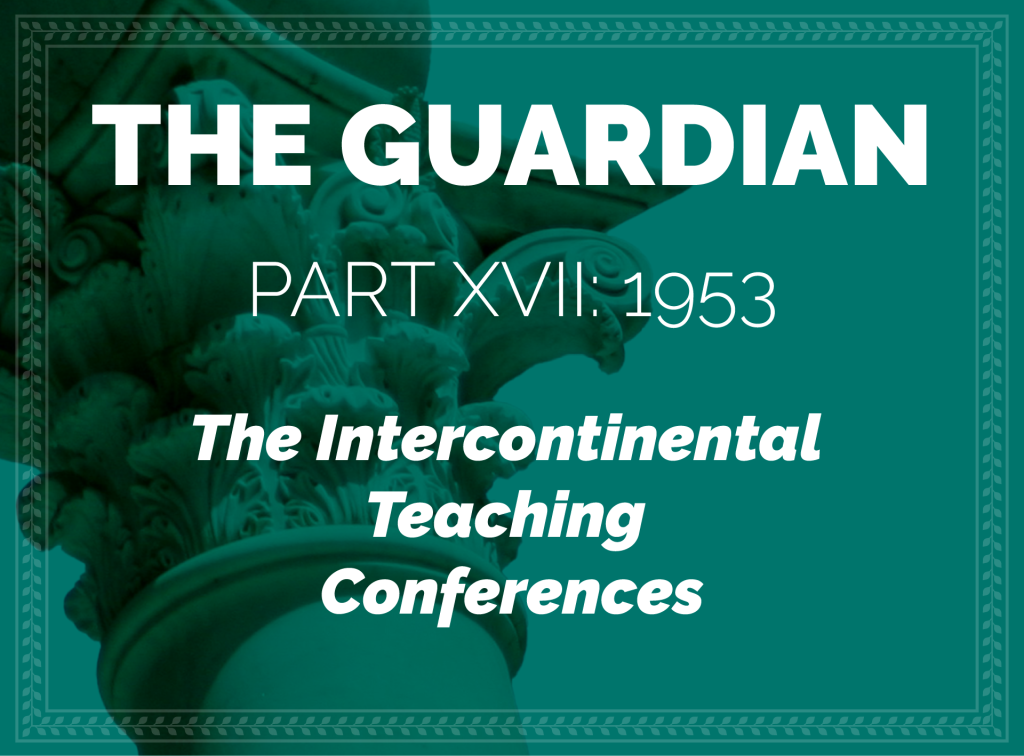
Written and illustrated by Violetta Zein
This part covers the life of Shoghi Effendi at the age of 56 in 1953.
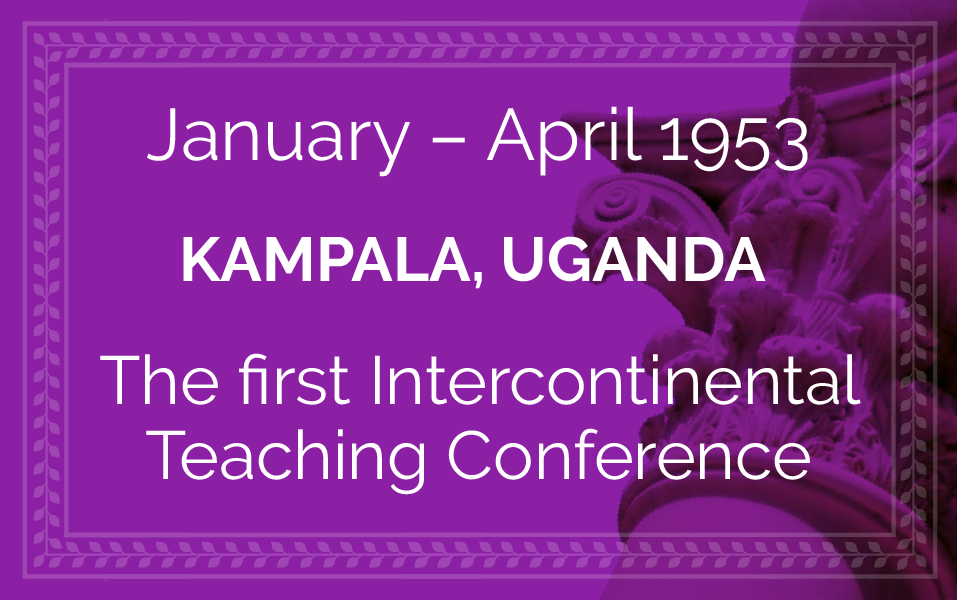
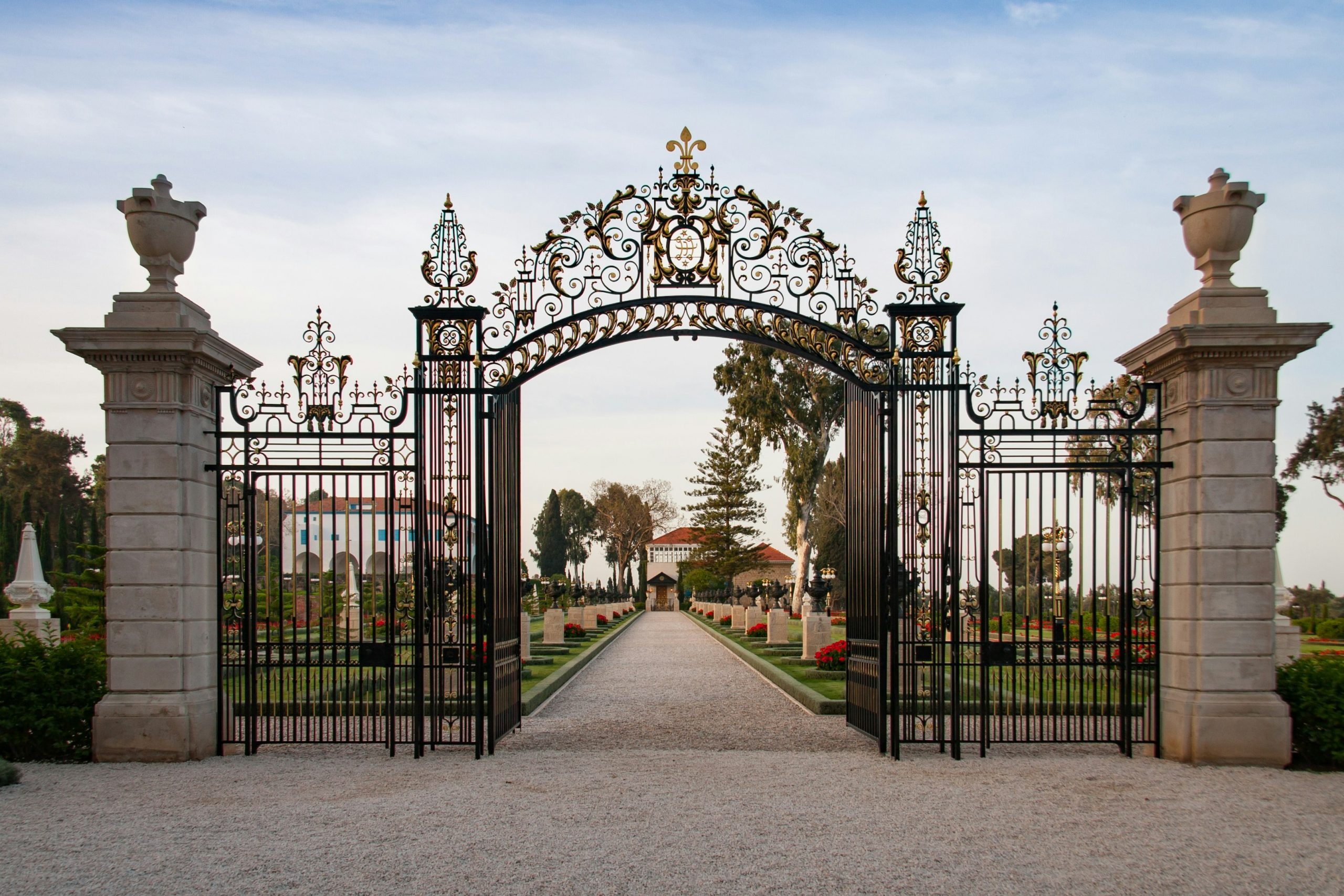
A view of the Shrine of Bahá’u’lláh from Collins Gate, named after Hand of the Cause of God Amelia Collins, the subject of the story below. Source: Bahá'í Media Bank, © Bahá'í International Community 2023.
The stately wrought-iron gate before the last straight white-pebble path leading directly to the Holy of Holies, the most sacred spot on earth, the Shrine of Bahá'u'lláh, is not just a wrought iron gate.
It has a name—Collins Gate—and it has a fascinating story.
It was Shoghi Effendi’s lifelong habit to spend several months each year in Switzerland for rest and recuperation.
The Guardian’s workload, his incessant worries, attacks of Covenant-breakers, and the fact he could not delegate his work or find full-time secretaries meant that he was always working on the verge of exhaustion, and while he was in Haifa, he could not rest. Work was always waiting. He had to leave, physically, in order to even attempt to restore some of his energy for the year that awaited him.
Often in Switzerland, the Guardian would keep in touch with work, and send important messages from there. He was not isolated or totally cut off, but he always returned to the simple and inexpensive apartment he had occupied in his youth, in his earliest stays in Interlaken in the 1920s.
One year, Amelia Collins noticed it was time for the Guardian’s retreat but he was still in Haifa.
She waited a couple of days, but then she had to go to Shoghi Effendi and ask him why he was not leaving for his annual holiday.
Shoghi Effendi replied that he had too much work.
But Amelia Collins did not give up so easily, especially when it came to her beloved Guardian’s health.
A few days later, she returned to see Shoghi Effendi and pleaded with him that his workload was too heavy, his hours were too long, and he needed rest.
Again, the Guardian replied he would leave if he could catch up on his work.
Again, a few days later, Amelia Collins noticed the Guardian busy with work and apparently not planning to leave for his much-needed vacation. She became very determined to ensure he got the rest he required and pleasantly insisted that he take time off in order for him to be able to shoulder his monumental responsibilities.
Amelia Collins insisted repeatedly until the Guardian turned her and said:
Amelia, I have no money to go on vacation.
This silenced Amelia Collins.
She went back to her room and gathered her savings, a total of $5,000—$57,000 in today’s currency—and returned to see Shoghi Effendi. She asked him, if the obstacle was purely financial, if he could accept her offering and go on vacation.
Finally, after a brief pause, the Guardian said:
Very well, I will go.
The next day, Shoghi Effendi left.
Ten days later, when Amelia was in Bahjí, she noticed a truck entering the grounds—a rare event. As the truck got closer, she noticed the Guardian was sitting in the passenger seat, next to the driver. As she approached the truck, extremely puzzled to see the Guardian still in the Holy Land, Shoghi Effendi exited the vehicle, beaming with joy and told her:
Amelia, I thought it better to use the money you gave me to order a large iron gate for the Holy Precinct and Bahjí Mansion rather than go on vacation. So I ordered this gate which is in the truck and waited until it was ready and brought it with me. I will have it installed, dedicated to your name.
A touching coincidence in this story is that Amelia Collins had loved and wanted a gate of her own, ever since she was a young girl. She would build little gates out of small bars of iron for her dollhouses, but they were never right. When she and her beloved husband Tom had built their home in New England, Tom had offered to build her a gate, but she had not wanted to invest money in a gate then.
Her longing for a gate had never been satisfied until the Guardian arrived at Bahjí with the most beautiful gate she could ever have imagined. He had given it to her without knowing she had always wanted one, and it was not just any gate. The Collins Gate was the gate that pilgrims walked through on their approach to the Shrine of the Supreme Manifestation of God, the gate by which they stood in reverent silence.
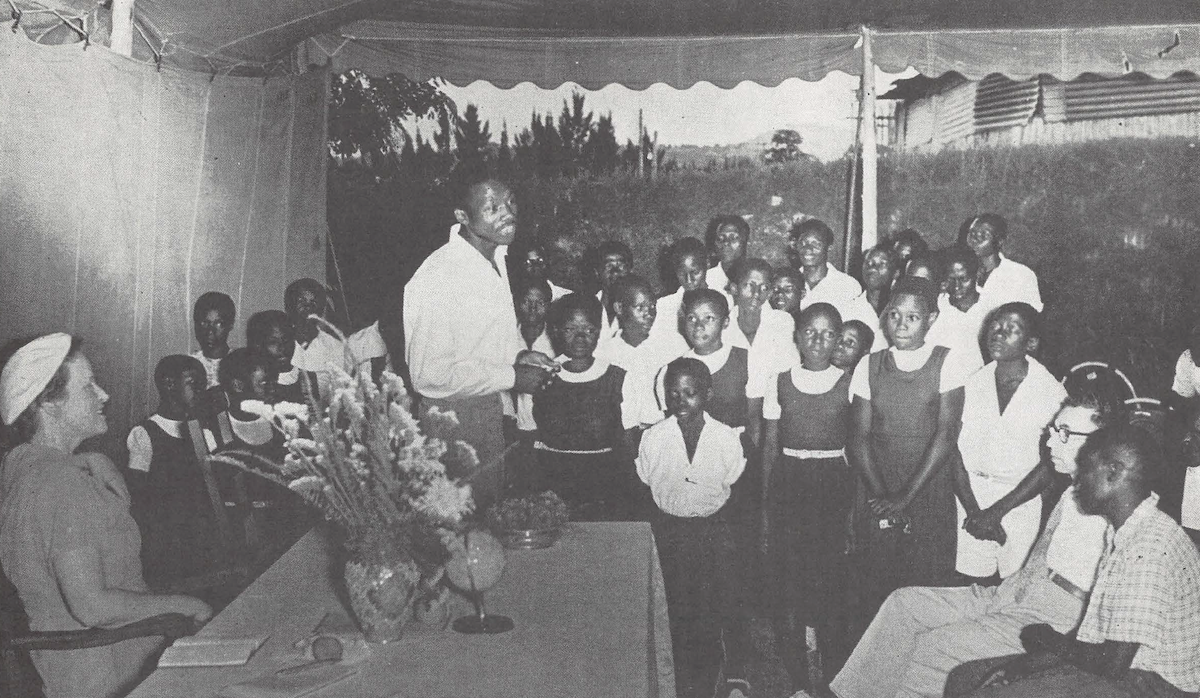
African choir at Kampala Conference public meeting, singing "Lord, I want to be a Baha'i with all my heart." Hand of the Cause Dorothy Baker is on the very left edge of the photograph, wearing a white head-covering. Source: The Bahá'í World page 126.
The first Bahá'í Intercontinental Teaching Conference which the Guardian had called for took place in Kampala, Uganda, from 12 to 18 February 1953 under a large and solidly built army tent, erected on the beautiful grounds of the Kampala Bahá'í center.
It was attended by 232 Bahá'ís representing 30 indigenous peoples of 19 countries in America, Asia, and with the majority of participants hailing from all corners of Africa. The conference languages were English, Swahili, Teso, and Persian.
The theme of the conference was “Light Over Africa,” and the participants consulted intensely on what was needed to carry out the Ten Year Crusade—which will be addressed in great detail in Part XVIII.
The Guardian sent a beautiful calligraphied scroll with portions of the Báb’s Qayyúmu'l-Asmá', the first Holy Book of the Bahá'í Dispensation, as well as a very beautiful and striking map of the world on which he had himself drawn the objectives of the World Crusade.
Hand of the Cause Leroy Ioas, the Guardian’s representative for the African Intercontinental Conference, shared his message to the assembled participants, which opened with his statement of love to the African people, recalling the words of Bahá'u'lláh Himself, who had compared the black people to the black pupil of the eye, through which the light of the spirit shineth forth.
The Guardian outlined 12 goals for Africa, the main ones being the formation of 3 new regional National Spiritual Assemblies, 33 new territories to be opened for the Faith, 24 to be consolidated, and purchasing land for 3 Houses of Worship in in Cairo, Kampala, and Johannesburg.
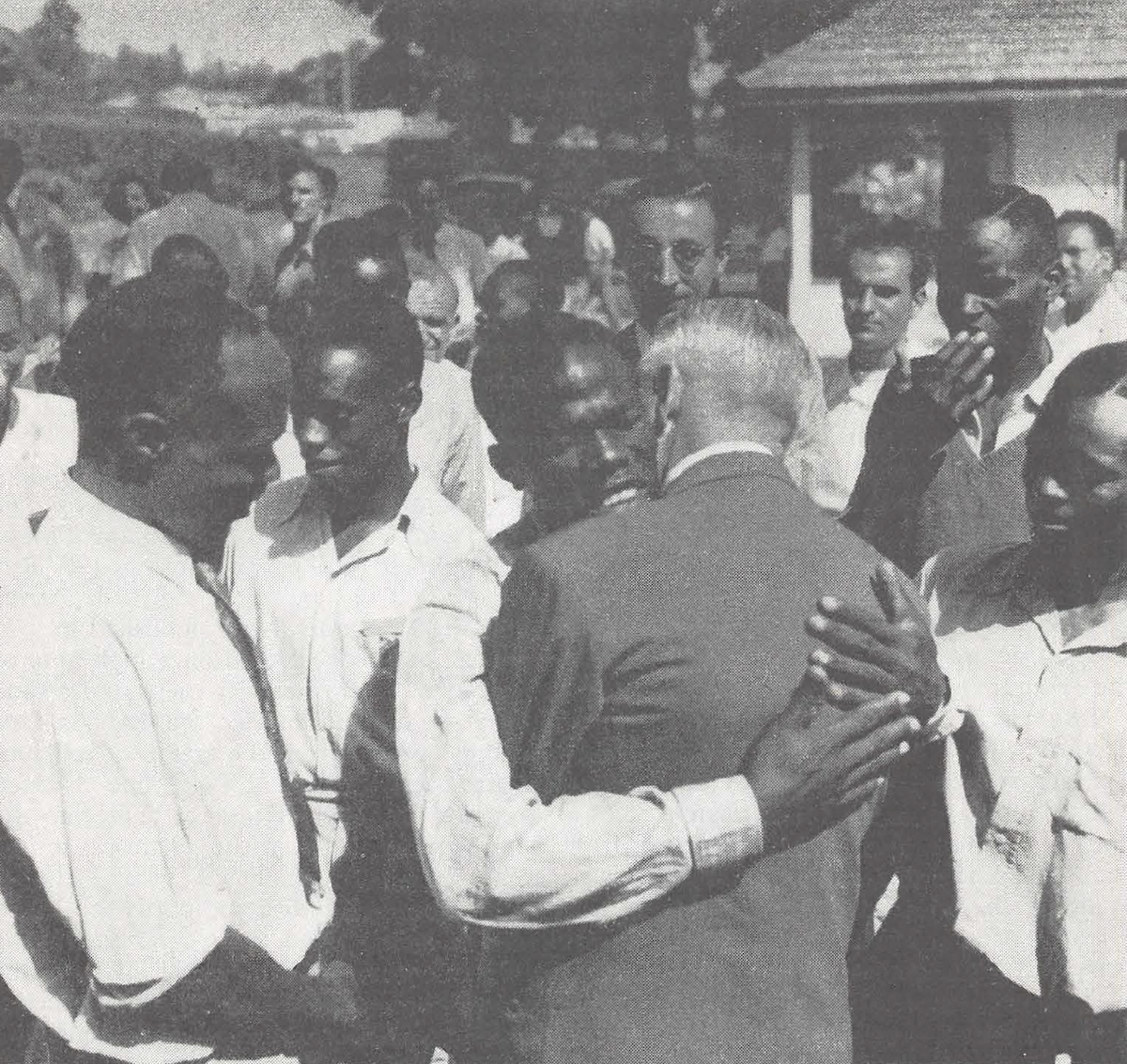
Leroy Ioas greeting African Baha'is on behalf of the Guardian, Kampala, Uganda, Africa, February, 1953. Source: The Bahá'í World page 129.
Shoghi Effendi was so wonderful that any friends he made became devoted to him. He knew how to keep lifelong friends. In 1953, 27 years after first meeting St. Barbe Baker in Haifa in 1926, when he became the first lifelong member of St. Barbe’s Men of the Trees organization, Shoghi Effendi called on his old friend for a great favor.
During the Intercontinental Teaching Conference in Kampala, Uganda, Shoghi Effendi entrusted his friend St. Barbe Baker to render him a great service by acting as host to the African Bahá'ís attending the Intercontinental Teaching Conference.
St. Barbe Baker’s duty each morning, was to take the caterer to the market so he could buy the food needed that day to feed the conference attendees. After this, St. Barbe Baker collected the African delegates from the club they were staying at and brought them himself to the Conference, returning them to their lodgings at night. There were so many participants, he had to do several trips each way, crowding 18 or 20 Bahá'ís in his Desert Humber, a truck he adored because it had taken him to the Sahara.
One night, his beloved truck was stolen. There was very little time to find the vehicle because as soon as they were stolen, they were disassembled and sold for parts. St. Barbe Baker rushed to see the Bahá'ís who suggested they all say nine Removers of Difficulties. Shortly after they had finished praying, the phone rang: St. Barbe Baker’s truck had been found 30 miles outside of Kampala.

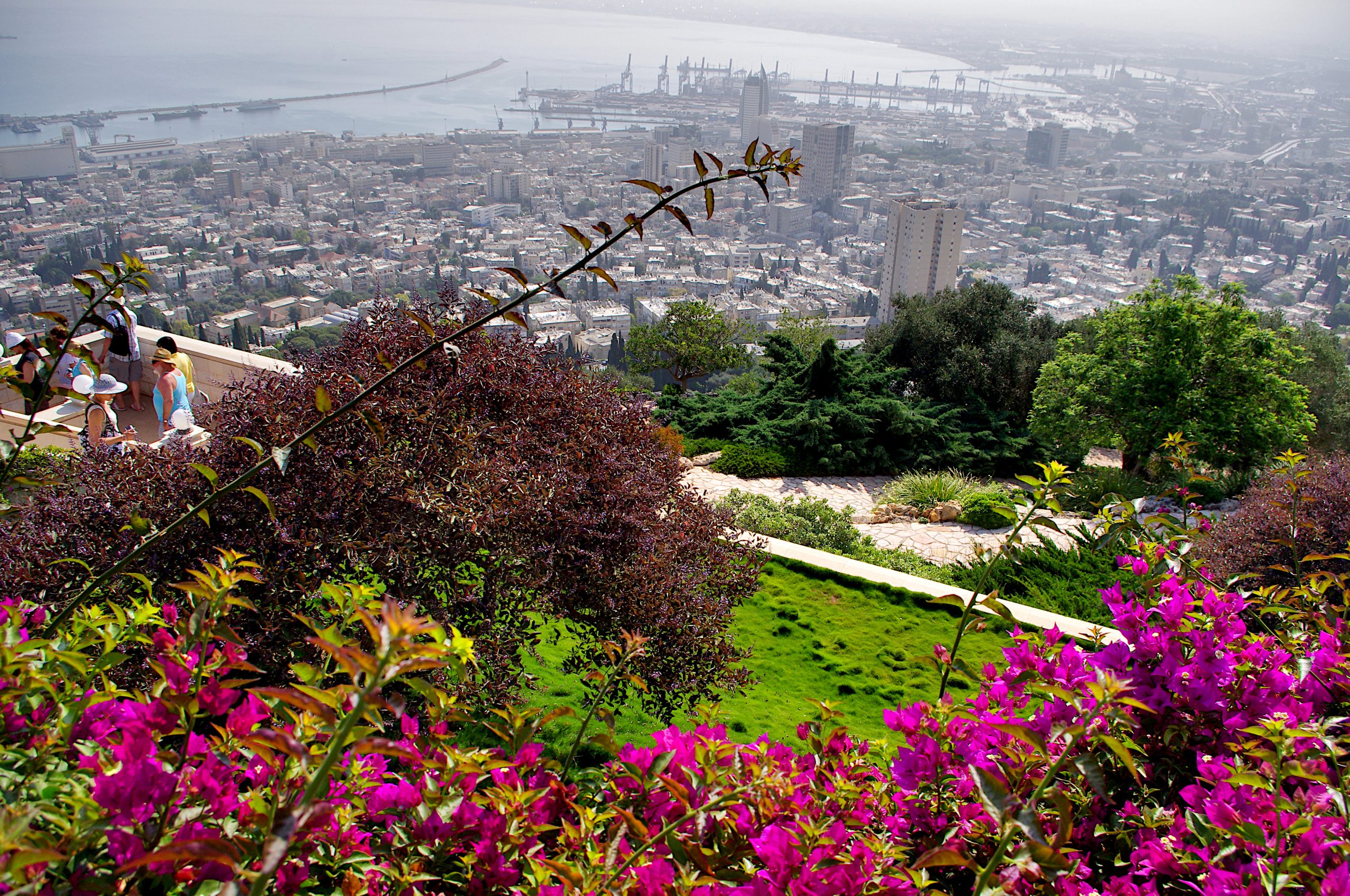
The Bahá'í terraces on Mount Carmel by Jan Helebrant. Source: Flickr (license CC0 Public Domain Dedication).
In March of 1953 Leroy Ioas finalized the purchase of six and a half acres of land on Mount Carmel, a property which the Guardian had desperately wanted for 30 years. Now, it was finally his, and he immediately extended the belt surrounding the Shrine of the Báb.
The Guardian shared the joyful news in his cable dated Naw-Rúz, 21 March 1953:
International endowments surrounding the tomb of the Prophet-Herald of the Faith on the bosom of God's Holy Mountain are considerably extended through the acquisition, after thirty years' effort, of a wooded area of over twenty-three thousand square meters, including a building overlooking the sacred spot, made possible through the estate bequeathed to the Faith by the herald of Bahá'u'lláh's Covenant, Roy Wilhelm, raising the total area within the precincts permanently dedicated to the Báb's Sepulcher to almost a quarter million square meters.
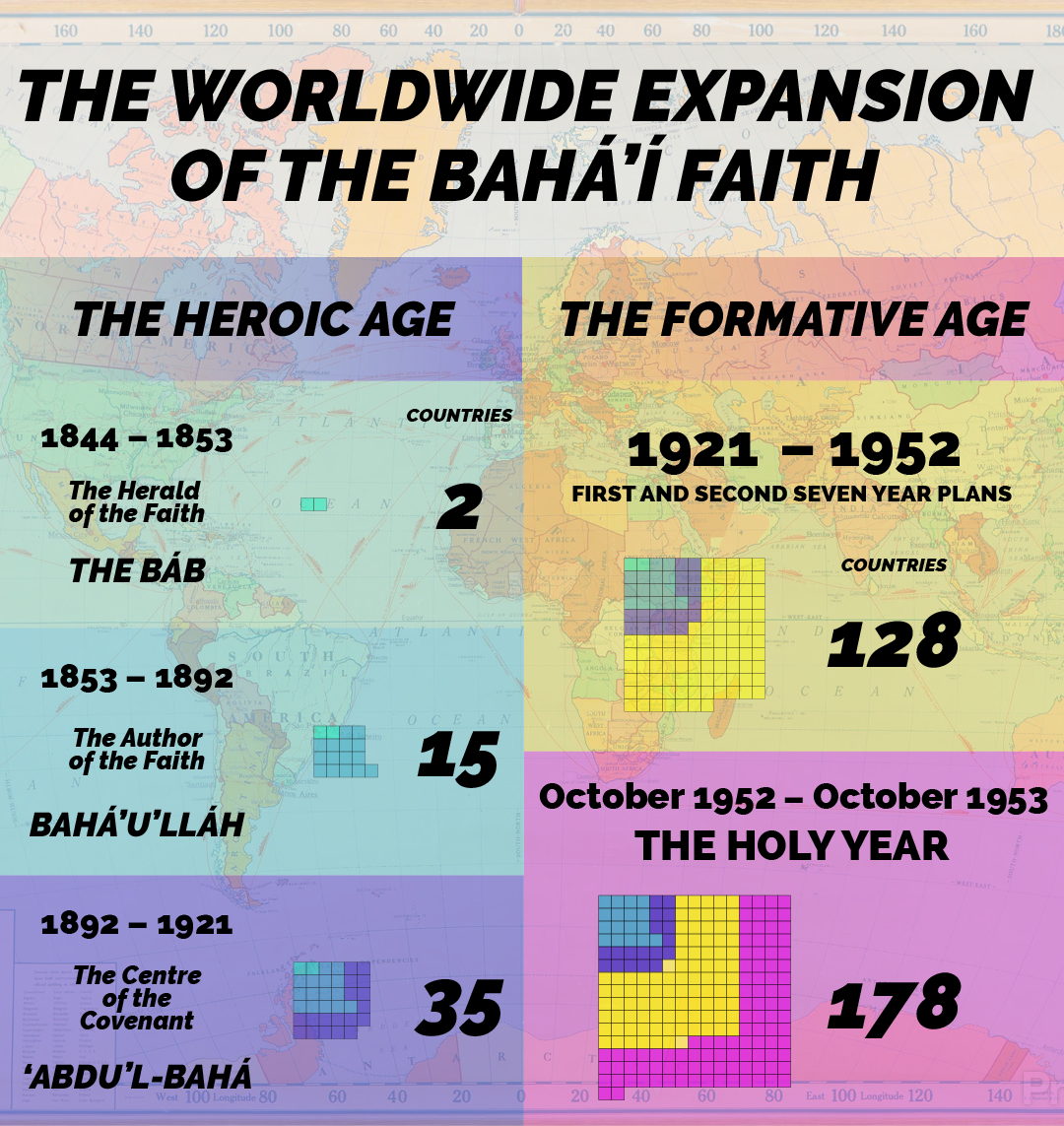
Expansion of the Faith at the end of the Second Seven Year Plan. Graphic based on the original published in Source: The Bahá'í World Volume 12, page 275.
When the second Seven Year Plan started, there were only two proper and long-standing national Bahá'í communities in Europe, the United Kingdom and Germany, both of which had National Spiritual Assemblies before the war. The National Spiritual Assembly of the United Kingdom was still functional but the German National Spiritual Assembly had been dissolved by the Nazis in 1937.
The Bahá'ís threw themselves into the crusade with so much enthusiasm, that by the second year of the Seven Year Plan, there were already 8 new Local Spiritual Assemblies in the United Kingdom and Germany.
The Guardian was an extraordinary source of encouragement throughout the entire plan, and no doubt maintained the resolve and dedication of the Bahá'ís in the field, but he also provided logistical help.
When the American community thought they might not be able to afford finishing the interior ornamentation of the House of Worship, Shoghi Effendi helped them reallocate funds to only strictly necessary expenses that could not be curtailed, and by 1950, they had raised half a million dollars.
By 1951, two more National Spiritual Assemblies had been elected, one in Central America, and one in South America.
By the end of the second Seven Year Plan, the Bahá'ís had consolidated the victories of the first Plan in Central and South America, established their respective National Spiritual Assemblies, consolidated the Ten Goal Countries of Europe, assisted the Guardian in finishing the superstructure of the Shrine of the Báb, and increased the number of National Spiritual Assemblies worldwide to 12.
After two successful American Seven Year Plans, the Guardian had tested the waters. The Bahá'ís who had successfully achieved their goals during the second Seven Year Plan had overcome all obstacles, and were exhilarated by their exploits, thanks to Shoghi Effendi’s constant encouragement.
The Ten Year Crusade was not a national one, but a world crusade. There would not be one plan, but rather twelve completely evolved plans, one for each National Spiritual Assembly, ready to be implemented as soon as Riḍván 1953 arrived.
The Bahá'í World was ready.
The worldwide Ten Year Crusade would be a watershed event which would transform the face of the Bahá'í community and bring Bahá'u'lláh’s Cause to every corner of the globe.
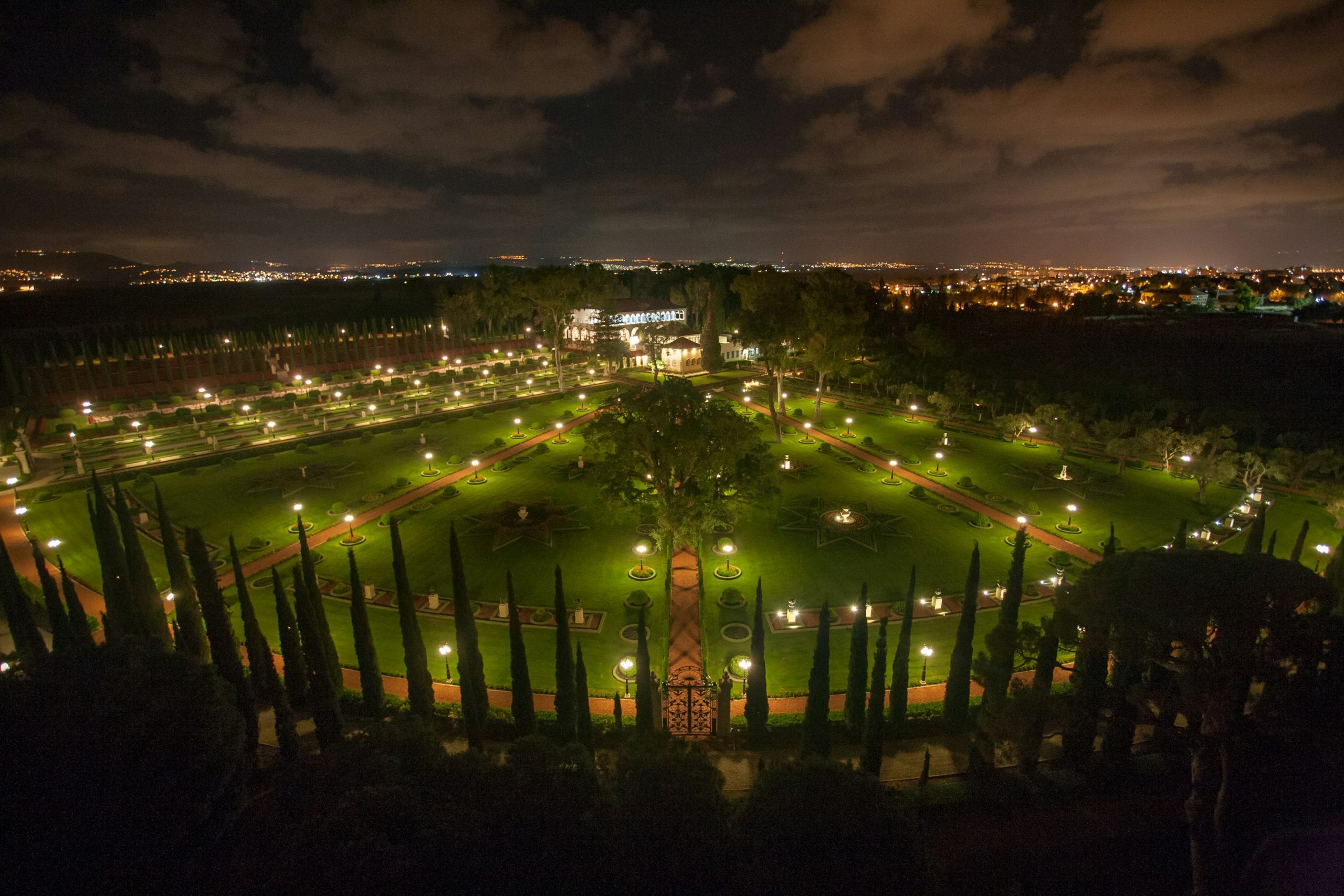
An aerial view of the Shrine of Bahá’u’lláh, the Mansion of Bahjí, and surrounding gardens at night, illuminated by the Guardian’s 99 lamp posts. Source: Bahá'í Media Bank, © Bahá'í International Community 2023.
The Guardian, like his Grandfather before him, had always loved light.
His powerful desk lamp blasted light onto his workspace, practically shining into his eyes, and his room was always brilliantly lit.
Over the years, Shoghi Effendi illumined the gardens around the Shrines of the Báb, 'Abdu'l-Bahá, and Bahá'u'lláh with beautiful four-branched wrought-iron lamp posts.
Shoghi Effendi installed 99 of these lamp posts in Bahjí alone, and when the first night arrived where they would be lighted for the first, time, at Riḍván 1953, the sky glowed over Bahjí, which, from a distance, looked like a small city.
The Guardian told the Persian pilgrims that it had always been light, but now it was "light upon light."
(In the original there is a beautiful play upon words alluding to Bahá'u'lláh as light.)
That evening, Bahjí was not the only Holy Place flooded with light.
Shoghi Effendi had illumined the Shrines of the Báb and 'Abdu'l-Bahá, as well as the Monument Gardens, the resting places of the Greatest Holy Leaf, and the mother, brother, and wife of 'Abdu'l-Bahá, and a powerful reflector bathed the International Archives Building in light.
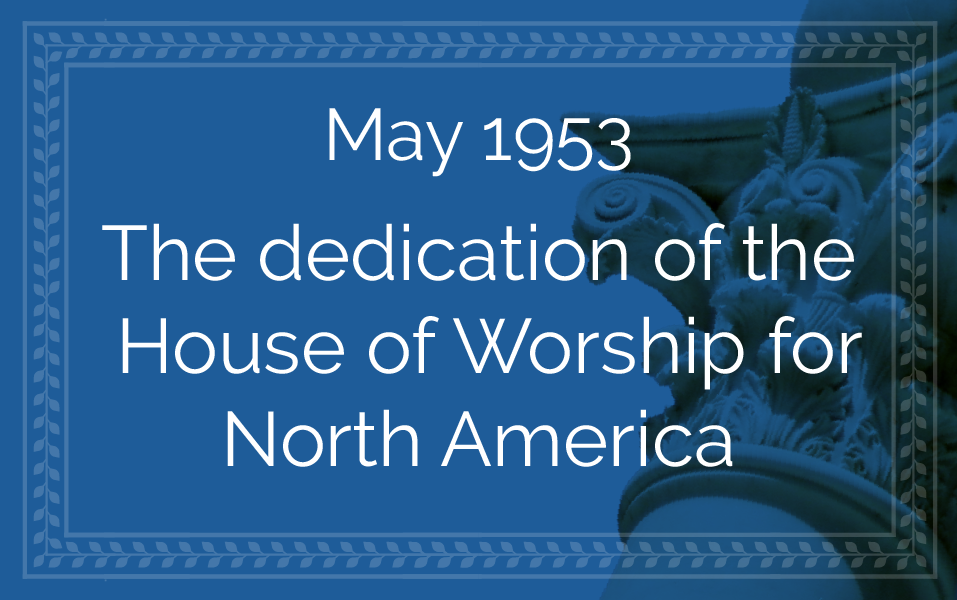
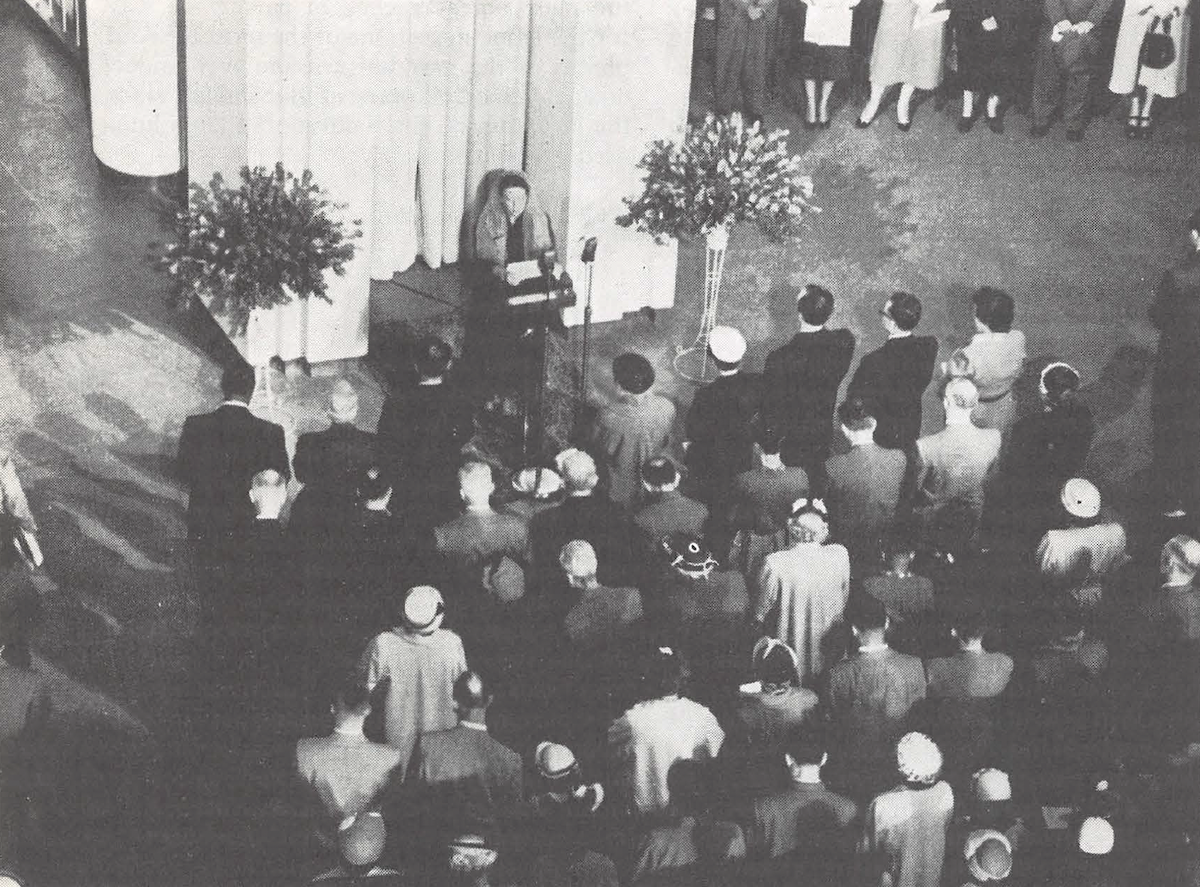
Rúḥíyyih Khánum presenting the Guardian's Message of Dedication of the Bahá'í House of Worship, Wilmette, Illinois, on 2 May 1953. Source: The Bahá'í World Volume 12, page 142.
On the Friday afternoon of 2 May 1953, Hand of the Cause Amatu’l-Bahá Ruḥíyyíh Khánum had the great honor of dedicating the first House of Worship in the western World, and shared a message from the Guardian, on this historic occasion, a half century after 'Abdu'l-Bahá had laid the foundation stone on 2 May 1912.
Rúḥíyyih Khánum rose, stately as a queen, an ethereal lacy scarf framing her beautiful face, and spoke epoch-making words:
Initiated fifty years ago, its foundation stone laid by ‘Abdu’l-Bahá, the son of the Founder of the Faith, raised by contributions from its followers all over the world, reared in the vicinity of the first Bahá’í center established in the West, this House of Worship, now opening wide its doors to peoples of all creeds, of all races, of all nations and of all classes, is dedicated to the three fundamental verities animating and underlying the Bahá’í Faith—the Unity of God, the Unity of His Prophets, the Unity of Mankind.
Two thousand five hundred Bahá'ís attended the dedication, which, after the words of the Guardian was followed by a simple consecration service, a private dedication, and a commemoration of 'Abdu'l-Bahá’s presence in that very spot, half a century ago.
William Sears gave a majestic dedication speech, drawing from millennia-old prophecies in the Old Testament including this one, from Zechariah chapter 6, verses 12 to 13, which prophecies not only 'Abdu'l-Bahá (The Most Great Branch) but the building of the House of Worship:
Thus speaketh the Lord of hosts, saying, Behold the man whose name is The Branch; and he shall grow up out of his place, and he shall build the temple of the Lord; Even he shall build the temple of the Lord; and he shall bear the glory, and shall sit and rule upon his throne….

Bahá'ís gathered in the House of Worship, Wilmette, Illinois, on the occasion of its Dedication. Source: The Bahá'í World Volume 12, page 145.
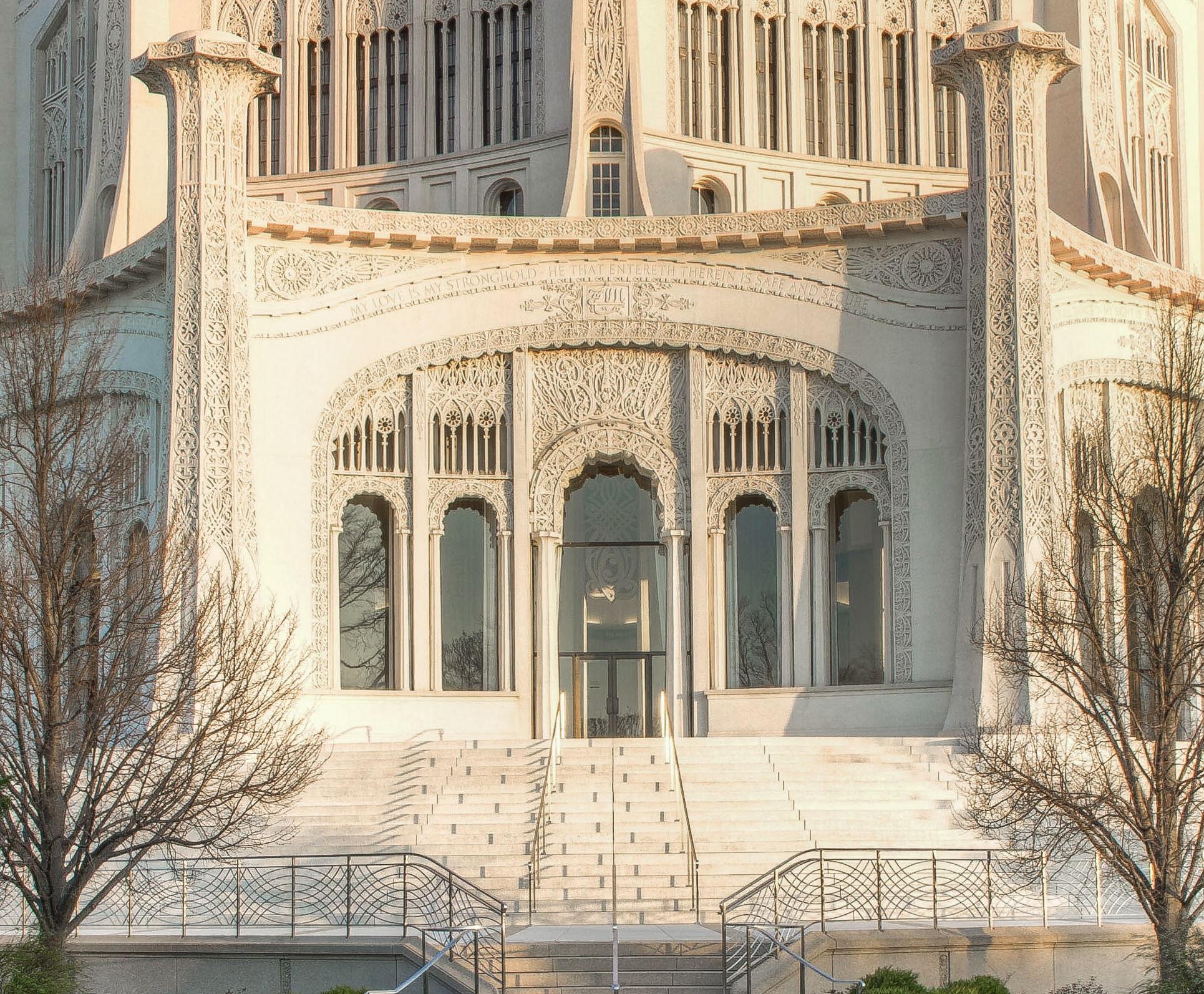
Inscription above one of the entrances of the Mother Temple of North America which reads “My love is My stronghold; he that entereth therein is safe and secure” from the Hidden Words from the Arabic, number 9. Source: photograph by Wenbinbin2010 - Own work, CC BY-SA 4.0, on Wikimedia Commons.
The Guardian chose the nine verses from the Writings of Bahá'u'lláh inscribed above each of the nine entrance doors to the House of Worship in Wilmette, along with the nine verses inscribed inside the inner alcoves of the doors.
Here are the nine quotations chosen by the Guardian for the outside of the House of Worship above each door:
- The earth is but one country and all mankind its citizens.
- The best beloved of all things in My sight is Justice—turn not away therefrom if thou desirest Me.
- My love is My stronghold—he that entereth therein is safe and secure.
- Breathe not the sins of others so long as thou art thyself a sinner.
- Thy heart is My home—sanctify it for My descent.
- I have made death a messenger of joy to Thee—wherefore dost though grieve?
- Make mention of Me on My earth that in My heaven I may remember thee.
- O rich ones of the earth—The poor in your midst are My trust—guard ye My trust.
- The source of all learning is the knowledge of God—exalted be His Glory.
Below are the nine quotations the Guardian chose to be inscribed on the inner alcoves of the nine doors:
- All the Prophets of God proclaim the same faith.
- Religion is a radiant light and an impregnable stronghold.
- Ye are the fruits of one tree and the leaves of one branch.
- So powerful is unity’s light that it can illumine the whole earth..
- Consort with the followers of all religions with friendliness
- Son of Being! Thou art My lamp and My light is in thee.
- O Son of Being! Walk in My statutes for love of Me.
- Thy Paradise is My love; thy heavenly home reunion with Me.
- The light of a good character surpasseth the light of the sun.

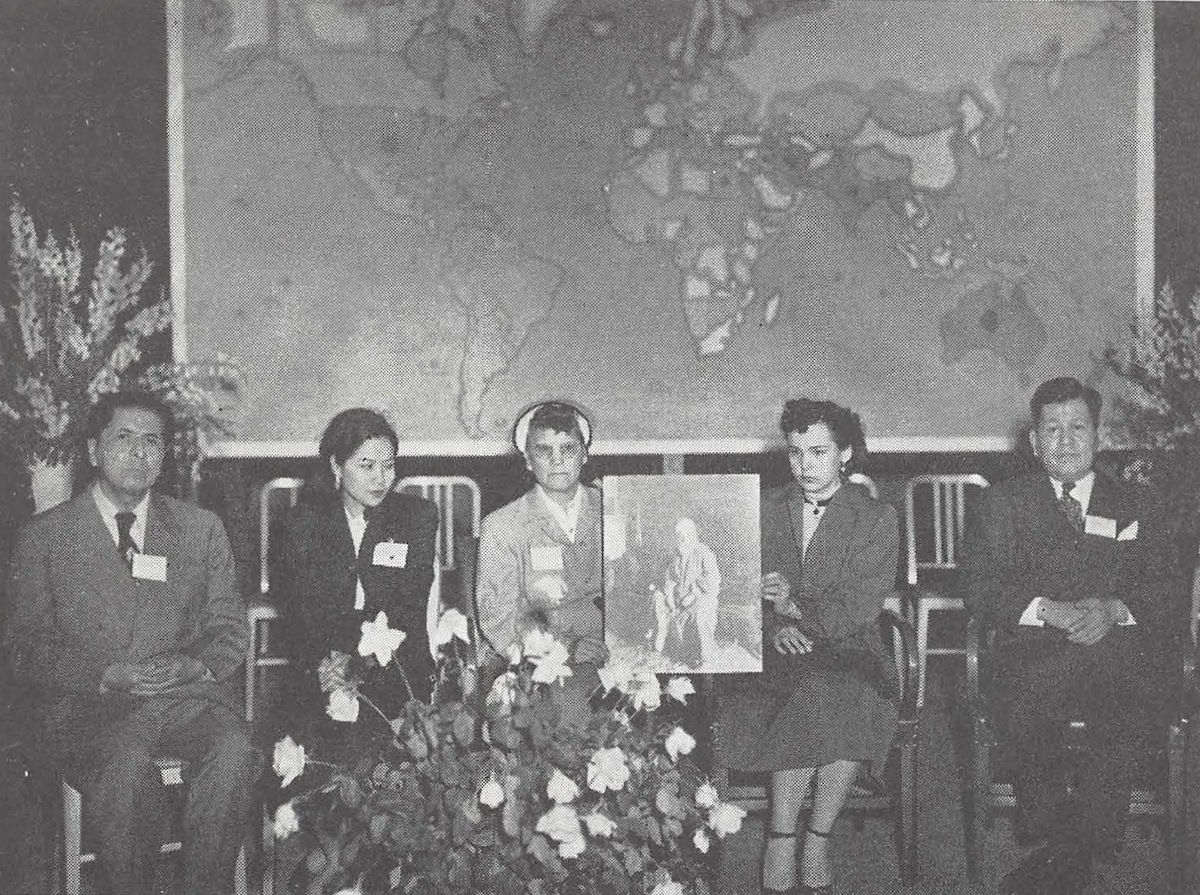
Native American Bahá'ís at the All-America Intercontinental Conference, Chicago, Illinois, May, 1953. Source: The Bahá'í World Volume 12, page 160.
The Guardian called the American Intercontinental Teaching Conference, “without doubt, the most distinguished of the four Intercontinental Teaching Conferences commemorating the Centenary of the inception of the Mission of Bahá’u’lláh.”
The conference took place in Chicago, Illinois, at the end of the Festival of Riḍván, from 3 to 6 May 1953 and in the spacious and comfortable Medinah Temple. Attendance was phenomenal: 2,109 American Bahá'ís attended, and another 235 Bahá'ís from 33 countries around the world, bringing the total attendance to 2,344.
It was in the city of the Conference, Chicago, that Bahá'u'lláh’s name was first mentioned publicly in the western hemisphere, exactly 60 years before, at the World Parliament of Religions in 1893.
As his special representative to the conference, the Guardian sent his wife, Hand of the Cause Amatu’l-Bahá Rúḥíyyih Khánum, bringing with her Shoghi Effendi’s sacred gift to the All-American Intercontinental Teaching Conference, the two portraits of the Báb and Bahá’u’lláh.
The Guardian outlined 13 goals for America, the main ones being the formation of 21 new National Spiritual Assemblies, 27 new territories to be opened for the Faith, 29 to be consolidated, and purchasing land for two Houses of Worship in Toronto and Panama.
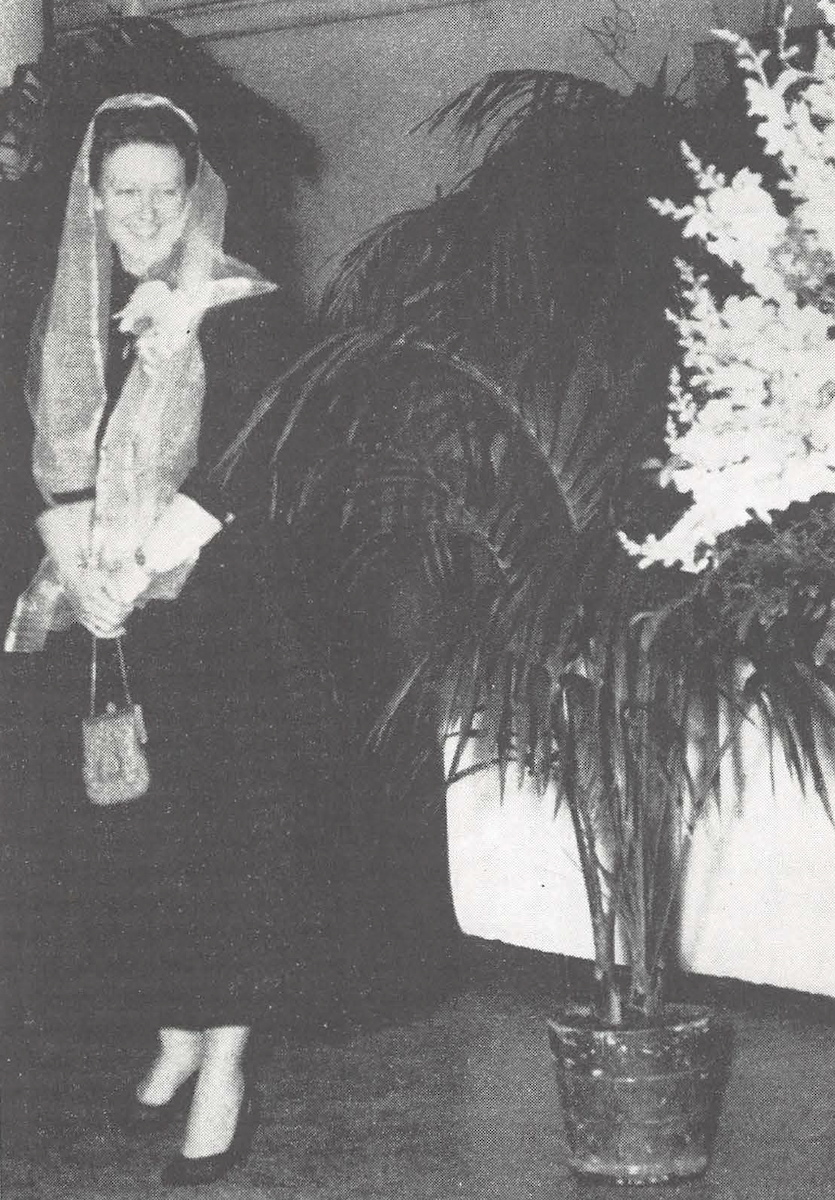
Photograph of Rúḥíyyih Khánum. At the All-American Intercontinental Teaching Conference in Chicago. Source: The Bahá'í World Volume 12, page 108.
The Guardian was overjoyed when he heard from Rúḥíyyih Khánum in America and told Leroy Ioas:
I have a cable from Rúḥíyyih Khánum in Chicago: they asked for pioneers to go out and settle these one hundred thirty-one countries, and more than one hundred and fifty people arose and offered to leave for these areas. Just think of it: if we send one person to each area we will have all of the countries settled. How wonderful it is, from this one Conference! I did not expect such a response as this.
Leroy Ioas had chaired the National Teaching Committee of the United States for 13 years and he knew the intimate lives of many of those prospective pioneers, as well as some of the problems they had.
Shoghi Effendi interrupted him:
Leroy, you stop it! I don't care how practical you are, I don't care how well you know America; nothing you can say is going to interfere with my joy and happiness tonight!
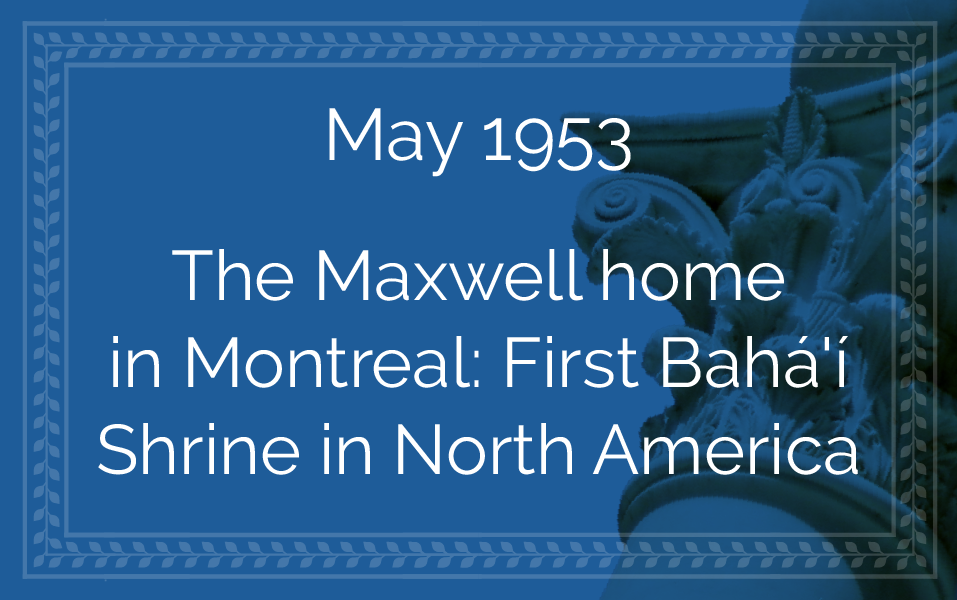
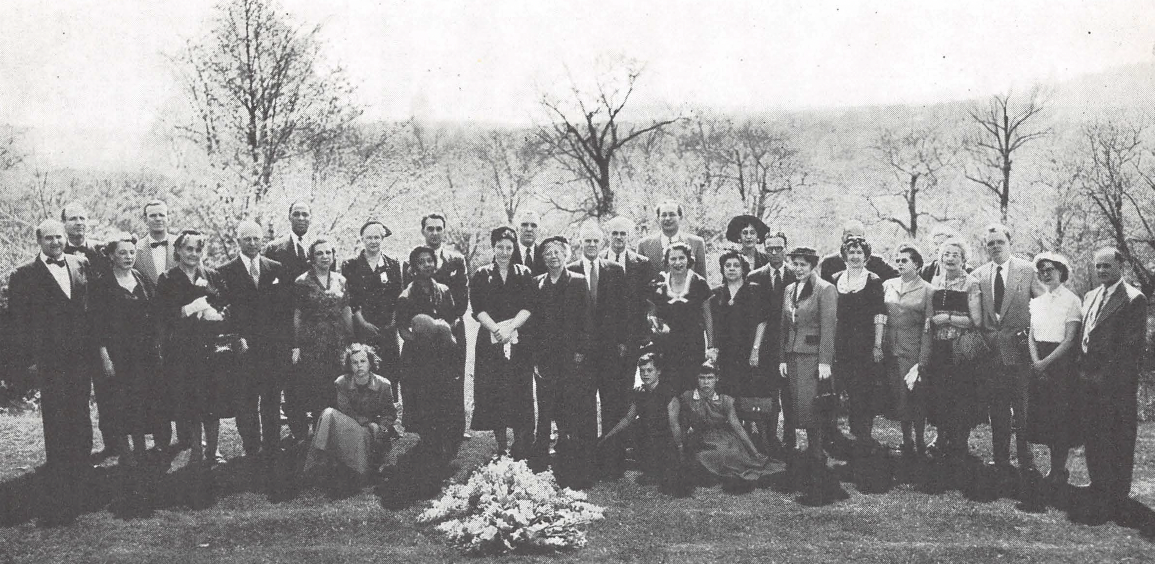
Rúḥíyyih Khánum at grave of her father, William Sutherland Maxwell, Hand of the Cause of God, in Mount Royal Cemetery, Montreal. Floral spray sent by the Guardian of the Baha'i World Faith from Haifa, in foreground. Mrs. Amelia Collins stands to the right of Rúḥíyyih Khánum, and others include National Spiritual Assembly members and Montreal Baha'is. May, 1953. Source: The Bahá'í World Volume 12, page 660.
In 1953, after the All-American Intercontinental Teaching Conference in Wilmette and Chicago, and the inauguration of the House of Worship for North America—at which Amatu’l-Bahá Rúḥíyyih Khánum was the Guardian’s representative, Rúhíyyih Khánum went to Montreal for the first time in 18 years, accompanied by Hand of the Cause Amelia Collins.
Rúḥíyyih Khánum had come to visit her father’s grave. She had requested that the monument he had designed for May Maxwell’s grave in Argentina be duplicated exactly for his resting place.
A surprise was awaiting because, as Rúḥíyyih Khánum said:
Shoghi Effendi did not forget those he loved; his faithfulness in all his relationships was very strong.
The Guardian had cabled the Local Spiritual Assembly of Montreal on 9 May 1953:
Instructed Montreal Assembly gather friends grave Sutherland pay tribute memory. Advise place blossoms Shrine also purchase hundred dollars choicest flowers mostly blue cover grave my behalf. Attach following inscription grateful memory Sutherland Maxwell Hand Cause talented dearly loved architect superstructure Bab's sepulchre Shoghi. Bring copies large size photograph friends assembled grave. Cable date time gathering for remembrance Shrine.
A memorial gathering in honor of William Sutherland Maxwell was held at his graveside on 10 May 1953, and Rúḥíyyih Khánum spoke that evening at a public event at the Ritz-Carlton Hotel.
While she was in Montreal, Rúḥíyyih Khánum sorted through her parents’ belongings and shipped her personal furniture—with Shoghi Effendi’s consent—to Haifa.
This was not where Shoghi Effendi’s empathy ended. His love for William Sutherland Maxwell was deep, and filled with respect, and he was also still grieving his loss. Rúḥíyyih Khánum describes Shoghi Effendi’s attentions before, during and after her visit to her father’s grave:
The thing that was most touching is that he should have not only given me in Haifa a vial of attar of rose to sprinkle on the grave, and flowers from the threshold of the Shrine of the Bab to place there, but should specify that he wanted me to buy mostly blue flowers, remembering that blue was the colour Sutherland always wore.
When I returned to Haifa Shoghi Effendi took many photographs I had brought, looked at them a long time, and kept them for himself.

Rúḥíyyih Khánum outside her family home, the Maxwell House in Montreal, Canada. Source: Bahá'í Canada.
Before leaving Haifa, Rúḥíyyih Khánum informed the Guardian that she intended to give the Maxwell family home at 1548 Pine Avenue to the National Spiritual Assembly of Canada.
It was the only home 'Abdu'l-Bahá had visited in all of Canada.
The Guardian was deeply pleased with Rúḥíyyih Khánum’s decision.
Rúḥíyyih Khánum’s trip to Montreal had two main objectives. To visit her father’s grave, and to make the donation of her family home as an endowment to the National Spiritual Assembly. This had been her mother’s dearest wish, and William Sutherland Maxwell had agreed.
None of the Maxwells felt it was really their home. They all felt it was 'Abdu'l-Bahá’s home and the Bahá'í Faith’s home, because 'Abdu'l-Bahá had said, while he had stayed with them:
This is my home, all that is in it is mine. You are mine – your husband and child. This is my home.
After she had shared with the Guardian that she wished to donate her family home, the Guardian had blessed the Maxwell family by calling their home a “Shrine” for the first time ever in his letter dated 20 June 1953 to the National Spiritual Assembly of Canada:
To this institution [the national headquarters] you will soon be adding the Maxwell Home in Montreal, which should be viewed in the nature of a national shrine, because of its association with the beloved Master, during His visit to Montreal. He sees no objection to having one room in the house being used as a little museum associated with Mr. and Mrs. Maxwell.
The house of the Maxwells at 1548 Pine Avenue had just entered Bahá'í history as the only Bahá'í Shrine in America.

Rúhí Afnán dove deeper and deeper into Covenant-breaking. His actions were so despicable that he forced the Guardian, who had just launched the Ten Year Crusade, to dim the enthusiasm of the Bahá'í world by sending yet another cable outlining the unfaithful activities of his cousin.
This is the cable Shoghi Effendi sent on 17 May 1953, just four days after he had strongly encouraged Bahá'í pioneers to scatter as widely as possible across the globe:
Treacherous Ruhi Afnán, not content with previous disobedience, correspondence with Ahmad Sohrab, contact with old Covenant-breakers, sale, in conjunction with other members of family, of sacred property purchased by Founder of Faith, and allowing his sister to marry son of Abdu'l-Bahá's enemy, is now openly lecturing on Bahá'í movement, claiming to be its exponent and is misrepresenting the teachings and deliberately causing confusion in minds of authorities and the local population. Informal National Assemblies.

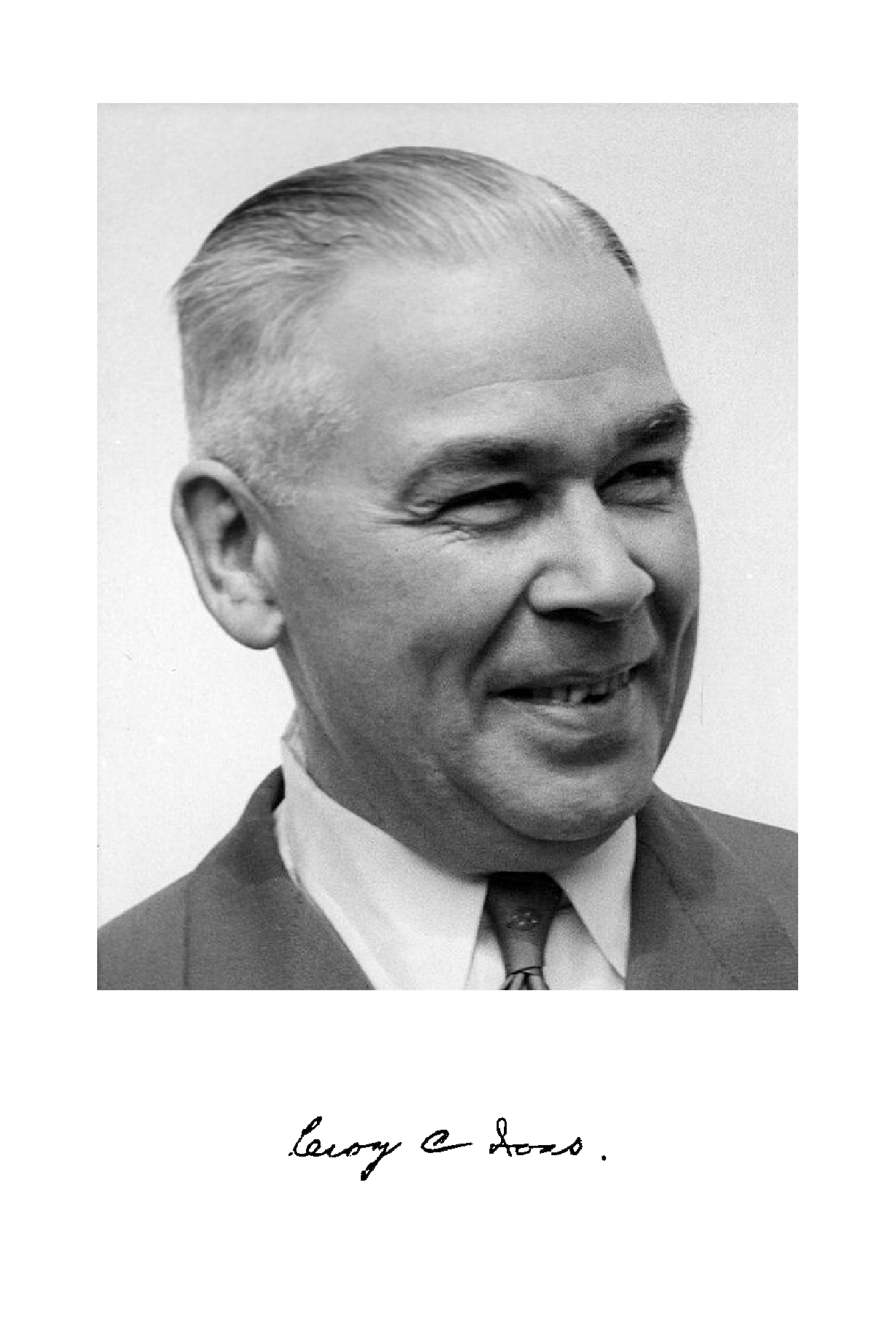
Hand of the Cause Leroy Ioas, the Guardian’s trustworthy and brilliant aide, and his signature, which, during his service to the Guardian was affixed to very important documents. Photograph of Leroy Ioas: Bahaimedia. Image of Leroy Ioas’ signature: Bahaimedia.
By 1954, Israel was developing at an astounding speed. Construction was booming and buildings and hotels were popping in Haifa, closer and closer to Mount Carmel.
The Guardian had to safeguard as much land as possible to protect the Shrine of the Báb and between 1954 and 1956, Hand of the Cause Leroy Ioas, the Guardian stalwart Secretary and right-hand man, his “Hercules,” worked tirelessly to safeguard the International Endowments of the Faith in a truly heroic manner. Over the course of these two years, Leroy Ioas would purchase several tracts of land that the Guardian had, for 30 years, ardently yearned for in vain. Leroy Ioas made the Guardian’s dreams come true.
One of the properties the Guardian had been anxious to purchase was owned by a Covenant-breaker which bisected properties already owned by the Bahá'ís.
At one time, the Guardian had offered the Covenant-breaker $60,000—around $700,000 in today’s currency—but he had refused to sell.
Then, something really interesting happened.
The civil authorities, anxious to preserve green space that would be open to the public, designated a large swath of land on Mount Carmel as permanent open space on which no one could build.
This meant that anyone owning land in that area was prohibited from building on their land, and when this became law, the Covenant-breaker’s property lost its commercial value, and he became anxious to get rid of his land, for which he had, for many years, paid land taxes.
In July 1953, Leroy Ioas purchased the Covenant-breaker’s land for a little less than $15,000—$170,000 today.
In a letter to an old friend, Leroy Ioas used this example as a cautionary tale for what happened to those who opposed the Will of God at the Bahá'í World Centre.

Hands of the Cause of God present at the Third Intercontinental Teaching Conference, Stockholm, Sweden, 21-26 July 1953. Source: The Bahá'í World Volume 12, page 169.
The European Intercontinental Teaching Conference was held in Stockholm, Sweden, from 21 to 26 July 1953 in the large auditorium of the Citizens Hall, decorated with pink gladiolas, yellow roses and carnations. There were 337 participants from 30 countries.
Hand of the Cause Ugo Giachery, the Guardian’s representative to the European Intercontinental Teaching Conference, shared his message to the assembled participants. The Guardian’s message called all European believers to participate in the spiritual regeneration of their continent.
Towards the end of the message, the Guardian speaks about Europe’s special place. First, Europe’s place in history, its strategic geopolitical location on the planet, its diversity of cultures, the home of modern civilization and the theater of religious history, both Christian and Muslim, as well as the home of reformation. But Shoghi Effendi also speaks about Europe’s hallowed place in Bahá'í history, having been visited by Bahá'u'lláh, during His exile in Edirne, and twice visited by 'Abdu'l-Bahá during His journeys to the West.
The Guardian outlined 13 goals for Europe, the main ones being the formation of 10 new National Spiritual Assemblies, 30 new territories to be opened for the Faith, 22 to be consolidated, as well as the construction of the European House of Worship in Frankfurt.

Volunteer pioneers for the Ten-Year Global Crusade, Third Bahá'í Intercontinental Teaching Conference, Stockholm, Sweden, July 21-26, 1953. Source: The Bahá'í World Volume 12, page 174.
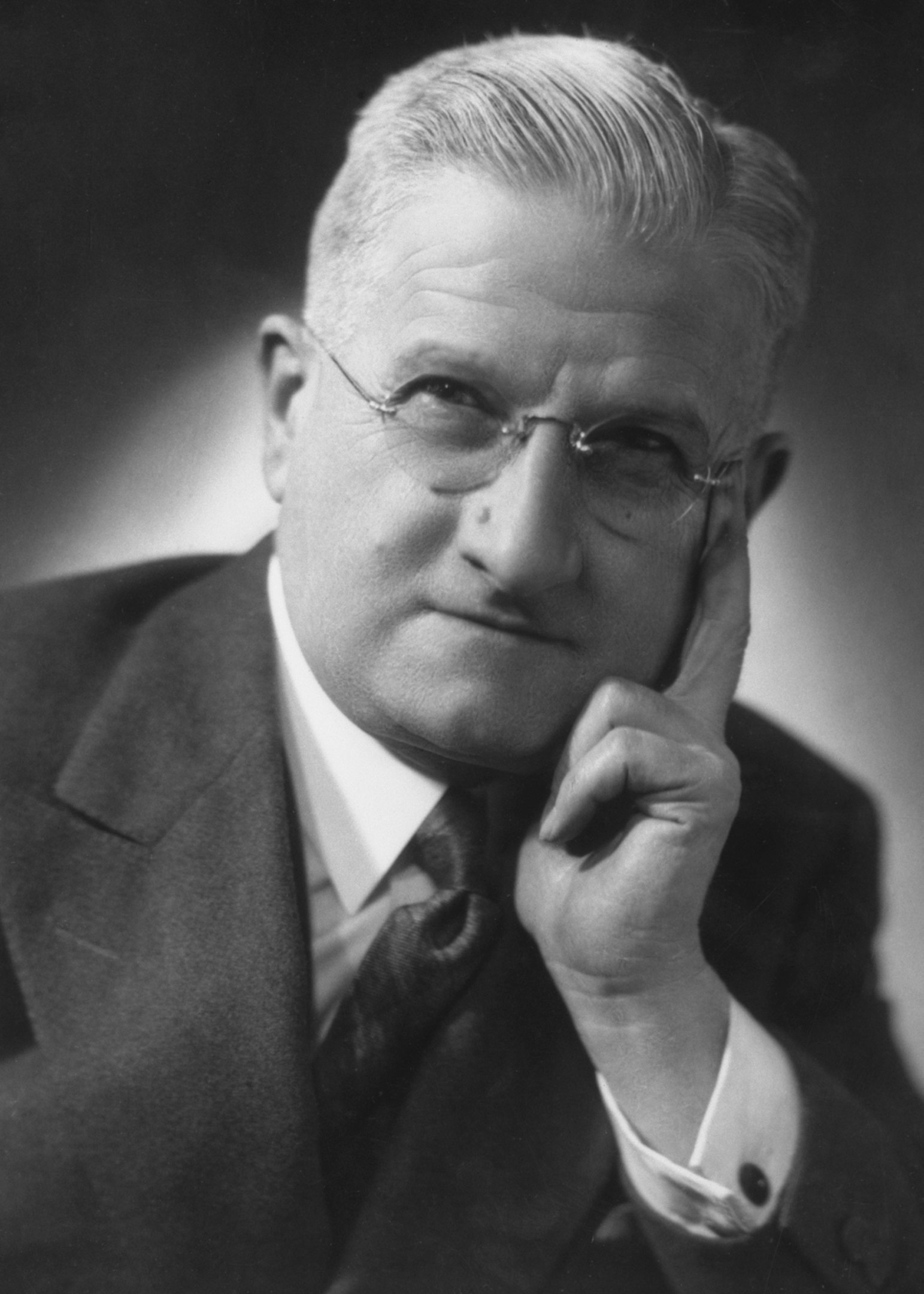
Siegfried Schopflocher (1877-1953). Source: Bahá'í Media Bank, © Bahá'í International Community 2023.
Although his given name was Siegfried, he was most widely known as Fred Schopflocher, and because that is how the Guardian referred to him in his cable eulogy, that is the name we have chosen to give him in this story.
Fred Schopflocher was born in Fürth, Bavaria, near Nuremberg, on 26 September 1877, the youngest of 18 children. Raised as an Orthodox Jew, he became an agnostic after leaving school and began an extended spiritual search. He started working for his brothers Nathan and Julius, in their bronze and aluminum powder factory in Frankfurt.
In January 1918 Schopflocher married Florence Evaline Snyder in New York City. She was universally known as Lorol. The couple had no children. A few years after they were married, they discovered the Faith and both became Bahá'ís at Green Acre in the summer of 1921.
They left for pilgrimage shortly after, but tragically arrived shortly after 'Abdu'l-Bahá’s Ascension on 28 November 1932. Fred was reborn as a Bahá'í after his pilgrimage and it was during a moment of immense spiritual emotion he shared with Saichiro Fujita, a staff member at the Bahá'í World Centre and dearly cherished by 'Abdu'l-Bahá that Fred Schopflocher Faith was confirmed.
Fred returned to Haifa to see Shoghi Effendi in 1924 and 1925, and they developed a close friendship. The Guardian called him a "zealous and promising disciple of ‘Abdu’l-Bahá."
Fred Schopflocher was elected to the National Spiritual Assembly of the United States and Canada in 1924–27, 1929–35, and 1938–44.
Fred and Lorol were a power couple. Fred was very a wealthy industrialist and had substantial business connections, and Lorol was a very talented speaker who would travel to 80 countries. They served the Faith without rest and Fred often carried out specific assignments for Shoghi Effendi.
Fred made substantial and remarkable contributions for the development of the American Bahá'í community including several large contributions to the building of the North American House of Worship and subsidizing the publication of The Bahá'í World. He also contributed part of the money Shoghi Effendi used to build the Collins Gate at Bahjí.
Most of Fred’s extended family were exterminated in Nazi concentration camps during World War II.
In 1947, Fred Schopflocher donated a permanent Bahá'í school property north of Montreal called Beaulac.
Fred Schopflocher played a crucial role in achieving the incorporation of the Canadian National Assembly by a special Act of Parliament in April 1949—an achievement Shoghi Effendi acclaimed as "a unique victory in the annals of the Faith in the East, and West."
While on pilgrimage in Haifa in January 1952, Fred Schopflocher heard directly from the Guardian the stunning news that he had been elevated to the rank of Hand of the Cause. Shoghi Effendi made the announcement to the Bahá’ís of the world on 29 February 1952. Fred traveled widely in Canada as a Hand of the Cause, speaking about Shoghi Effendi’s work and vision.
In late April – Early May, he attended the All-American Intercontinental Teaching Conference held in Chicago as one of the Guardian’s representatives. He was planning to attend the Asian conference when he became ill.
His condition worsened very rapidly and he passed away on 27 July 1953 at 7:30 AM. He was laid to rest in the Mount Royal Cemetery in Montreal, close to the grave of William Sutherland Maxwell.
Fred Schopflocher—like all Hands of the Cause—had extraordinary personal virtues. He was sweet and ardent, he was genuinely, and profoundly humble and selfless, He was also simple and unassuming. He was famously punctual. He was never late for any meeting, and often said he preferred being ten minutes early than one minute late. Fred’s simplicity was legendary. He was completely egalitarian. When he traveled from Montreal to his powder factory in Malone, New York, he didn’t sit in the passenger wagons. He sat in the baggage car, playing cards with the railway workers.
At his funeral, a number of his cribbage friends—railway workers and border guards—attended his funeral. This was Shoghi Effendi’s late July 1953 eulogy cable message to the North American Bahá'ís:
Profoundly grieved at passing of dearly loved, outstandingly staunch Hand of Cause Fred Schopflocher. His numerous, magnificent services extending over thirty years in administrative and teaching spheres for United States, Canada, Institutions at Bahá’í World Center greatly enriched annals of Formative Age of Faith. Abundant reward assured in Abhá Kingdom. Advising American National Assembly to hold befitting memorial gathering at Temple he generously helped raise. Advise hold memorial gathering at Maxwell home to commemorate his eminent part in rise of Administrative Order of Faith in Canada. Urge ensure burial in close neighborhood of resting place of distinguished Hand of Cause Sutherland Maxwell.
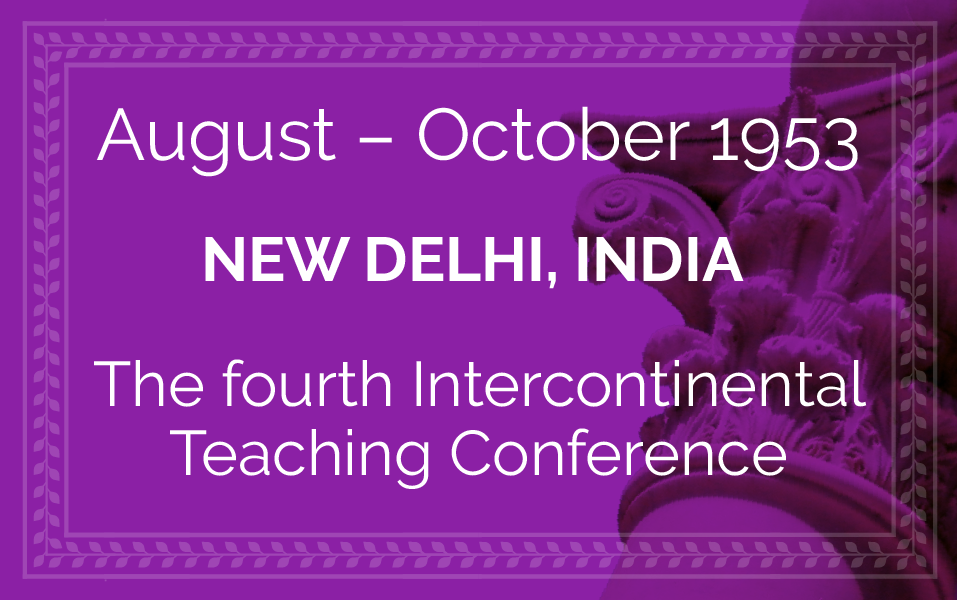
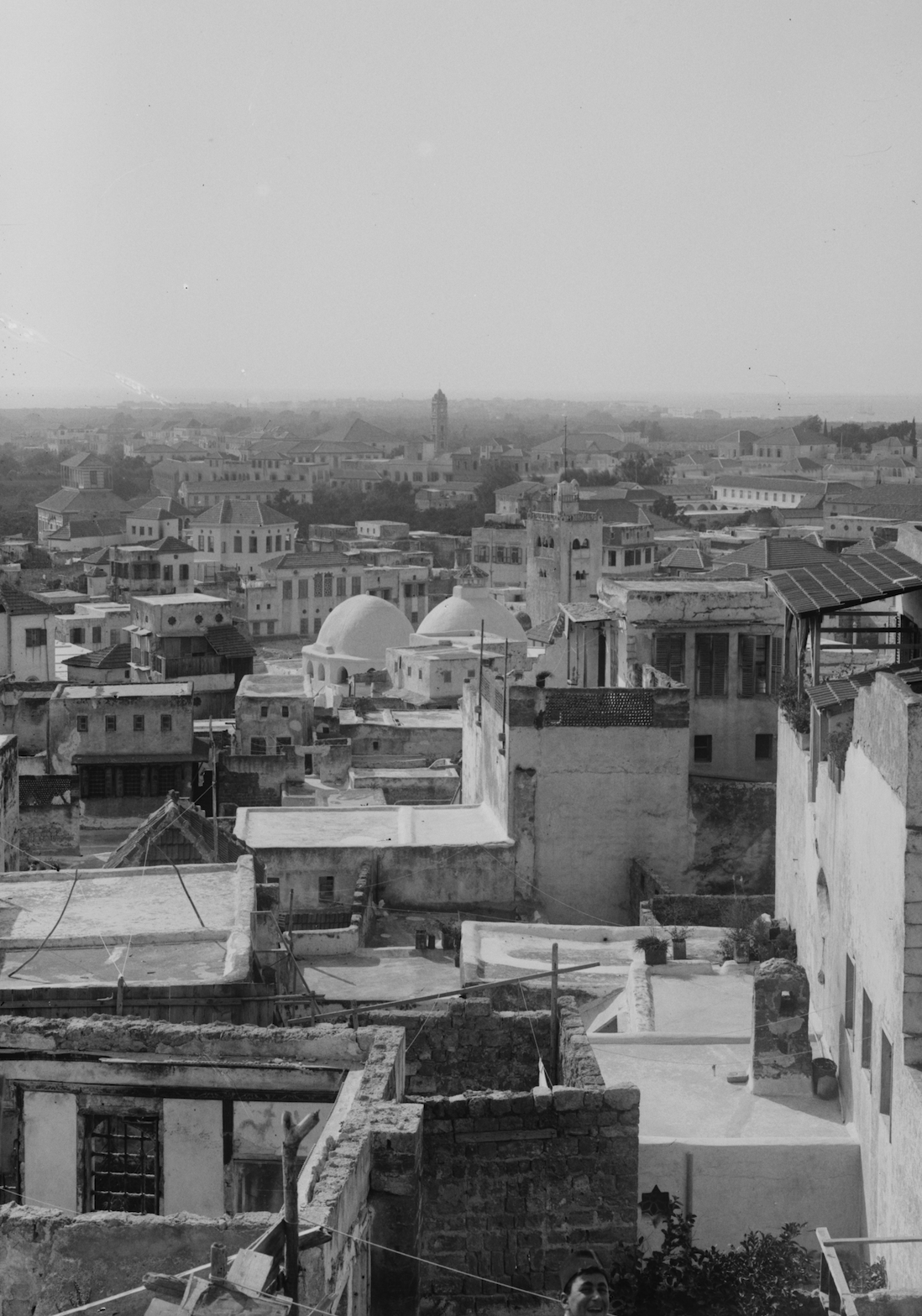
Tripoli, Libya in the first half of the 20th century. Source: Library of Congress.
Ella Bailey was born in Houston, Texas, on 18 December 1864, and shortly after, her family settled on a ranch in San Diego County, California. Ella Bailey contracted polio at the age of 2 and became disabled, and spent an entire life in pain. She grew up to be very beautiful, but made a choice not to get married. Even as a young girl, Ella Bailey had an ardent desire to serve, so became an elementary school teacher, dearly beloved by her students. Even decades later, her students never forgot her.
It was Lua Getsinger who taught Ella Bailey about the Bahá'í Faith, and she became a Bahá'í shortly before 'Abdu'l-Bahá’s visit to America. She met 'Abdu'l-Bahá in Chicago, in 1912, and the Master told her:
My child, you are going to suffer. You are going to have a great deal of sorrow, and you are going to have a great deal of pain. Life is going to be hard.
Those words of 'Abdu'l-Bahá to Ella Bailey became her source of strength, as she herself explained:
In those few words, He gave me all the emotions of a lifetime. He gave suffering but with it He gave me faith and strength. This made me feel His spiritual power and His truth.
Ella Bailey became the Chairman of the first Berkeley Local Spiritual Assembly, and served as a member for more than 20 years. She was a tireless teacher of the Faith, constantly spreading the Teachings of Bahá'u'lláh by word and by deed, but she avoided public speaking and the limelight, preferring to serve in the background. Her hospitality was legendary, and she was famous for her gentleness and sweetness. She spent her days comforting the downtrodden, helping the needy, visiting the sick, and refreshing the spirits of her endless stream of visitors. She led a saintly life.
When Ella Bailey learned that Shoghi Effendi had expressed the desire that Robert and Bahíyyih Gulick pioneer to Africa, she wanted to accompany them, but did not wish to be a burden, so the Gulicks cabled the Guardian and he responded with four words:
Approve Bailey accompany you.
Ella Bailey attended the dedication of the Mother Temple of North America on 2 May 1953, and left California on 14 July 1953, never to return. Stopping over in New York City, Ella Bailey met Hands of the Cause Dhikru’lláh Khadem and Músá Banání.
Ella Bailey was 88 years old and in very poor health. She had contracted pneumonia in California before leaving, she fell once in New York City, and again fell in Rome, and she arrived in Tripoli, Libya, breathing through an oxygen mask, on 20 July 1953. During her first month in Tripoli, Ella Bailey fell several more times, always apologizing for being a burden, and always grateful to her loving hosts and friends.
On 26 August 1953, a former member of the National Spiritual Assembly of Egypt, accompanied by a young Persian seeker visited Ella Bailey at 7:30 PM, and 30 minutes later, at 8:00 PM, she passed away.
The young Persian seeker became a Bahá'í soon after and became the first Bahá'í pioneer to Fizan, Libya. The Bahá'í community gathered at Ella Bailey’s bedside and said prayers for her and an Egyptian friend kissed her forehead and tearfully bid her farewell, saying:
Goodbye, Miss Bailey.
Ella Bailey was buried on 27 August 1953 and the Guardian paid for her funeral.

A photograph of Ella Bailey from her In Memoriam article in The Bahá'í World Volume 12, page 687.
The evening Shoghi Effendi found out Ella Bailey had died, Leroy Ioas asked the Guardian if he might relate a story about Ella Bailey. When he was Treasurer of the National Spiritual Assembly of the United States, the American Bahá'ís had to raise $1 million dollars to complete the ornamentation of the North American House of Worship. During a business trip to San Francisco, Ella Bailey said to Leroy Ioas:
You need a lot of money for the Temple; I don't have much money. But I have one hundred and fifty dollars for my burial and I want you to take it for the Temple. I will ask in my Will to be buried in a pauper's grave. What good is this body anyway, she said, it has given me pain all my life.
Leroy Ioas explained to Ella Bailey:
We don't need a hundred and fifty dollars, Ella, we need one million dollars. You keep that hundred and fifty dollars and have a proper burial; you are entitled to that.
No, she said, my mind is made up.
And she gave him her check for the Fund.
Leroy told the Guardian:
Shoghi Effendi, here is a woman who had given up the money for her burial, here is a woman willing to be buried in a pauper's grave, yet who becomes a martyr to the Cause of God, and the Guardian of the Cause, the sign of God on earth, is building her monument. This is surely one of the great sacrificial victories.
On 30 August 1953, the Guardian cabled,:
Grieve passing valiant exemplary pioneer. Reward Kingdom bountiful.
Shoghi Effendi requested three American Bahá'ís in Tripoli submit a design for a suitable memorial for her.
In his 7 October 1953 message to the Asian Intercontinental Teaching Conference in New Delhi, India, the Guardian spoke about Ella Bailey’s martyrdom:
The irresistibly unfolding Crusade has been sanctified by the death of heroic, eighty-eight year old Ella Bailey, elevating her to the rank of the martyrs of the Faith, shedding further luster on the American Bahá'í Community and consecrating the soil of the fast-awakening African continent.
On the elaborate map the Guardian produced of the goals for the Ten Year Crusade, he put a gold star on Tripoli, the place of Ella Bailey’s Martyrdom, and said:
This is Ella Bailey.
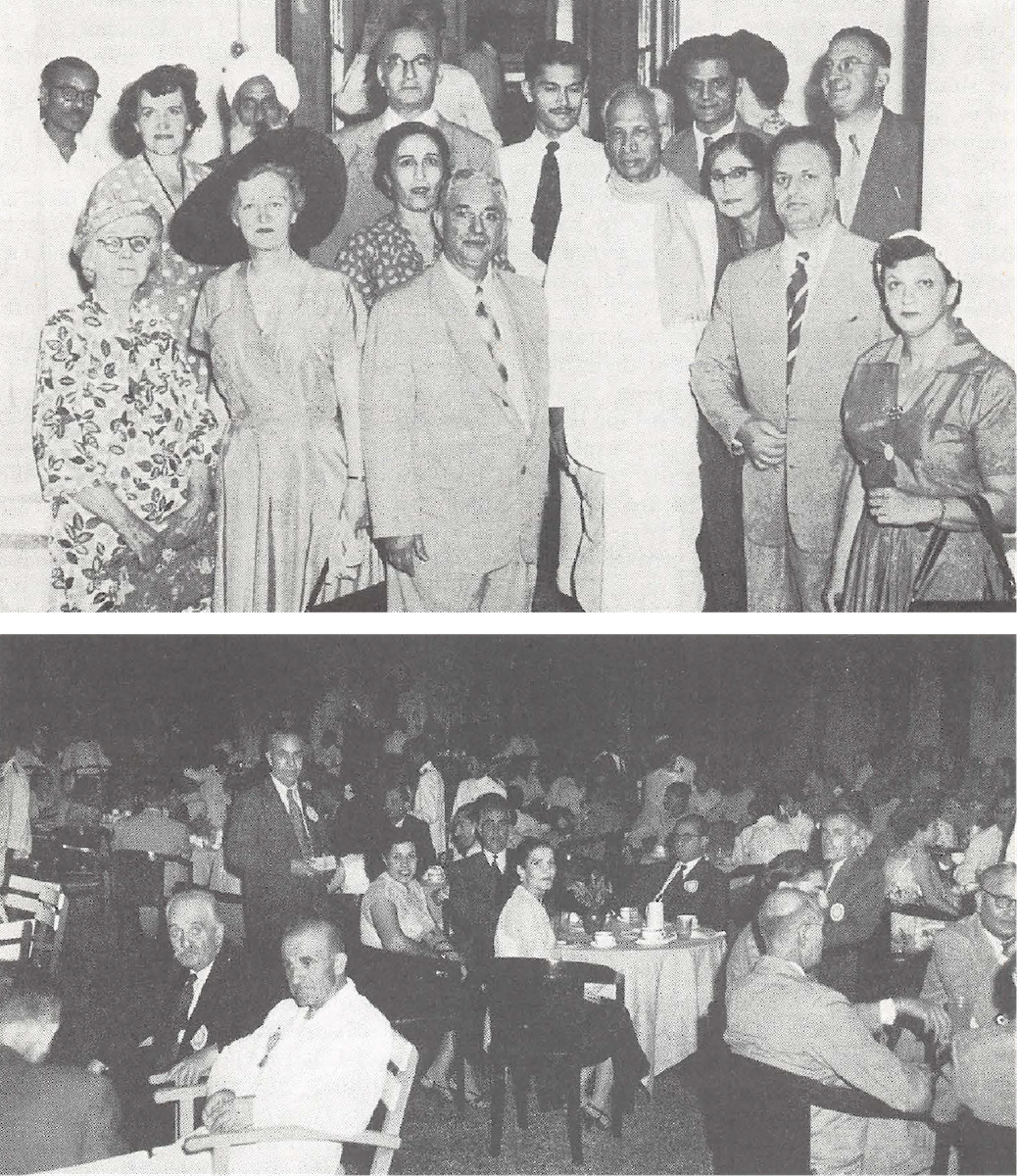
Top photograph: Dr. S. Radhakrishnan, Vice-President of India, with some members of the Bahá'í delegation, New Delhi, 5 October, 1953. Source: The Bahá'í World Volume 12, page 185. Bottom photograph: Public reception held during the Fourth Bahá'í Intercontinental Teaching Conference, New Delhi, India, October, 1953. Source: The Bahá'í World Volume 12, page 187.
The last Intercontinental Teaching Conference, took place with the closing of the Holy Year, from 7 to 15 October 1953 in New Delhi, India. There were 489 participants from 31 countries, gathered under the colorful tent raised on the grounds of the Constitution Club.
In attendance, were twelve Hands of the Cause: the five Hands of the Cause from Iran: Ṭaráẓu'lláh Samandarí, ‘Alí-Akbar Furútan, Dhikru’lláh Khadem, Valíyu’lláh Varqá, and Shu‘á‘u’lláh ‘Alá’í, as well as Dorothy Baker, Amelia Collins, Horace Holley Mason Remey, Ugo Giachery, Clara Dunn, and Músá Banání, Hand of the Cause from East Africa.
The Guardian outlined 13 goals for Asia, the main ones being the formation of 11 new National Spiritual Assemblies, 41 new territories to be opened for the Faith, 43 to be consolidated, the construction of the Bahá'í House of Worship in Ṭihrán, Iran, and the purchase of land for 3 Houses of Worship in Baghdad, New Delhi, and Sydney.
During the conference, 74 pioneers rose up to fill the goal of opening new territories to the Faith, and after being interviewed by a special committee, 25 left for their pioneering post immediately after the conference.
The Indian National Spiritual Assembly also chose the site for the future House of Worship of Asia, a property of nine acres, overlooking New Delhi.
In his special message to this conference, the Guardian outlined what made Asia special among all other continents:
The Asiatic continent, the cradle of the principal religions of mankind; the home of so many of the oldest and mightiest civilizations which have flourished on this planet; the crossways of so many kindreds and races…above whose horizons, in modern times, the suns of two independent revelations—the promise and consummation of a six thousand year old religious cycle—have successively arisen; where the Authors of both of these revelations suffered banishment and died; within whose confines the Center of a divinely appointed Covenant was born, endured a forty-year incarceration and passed away; on whose western extremity the Qiblih of the Bahá'í world has been definitely established…such a continent, so privileged among its sister continents and yet so long and so sadly tormented, now stands at the hour of the launching of a world-encompassing Crusade, on the threshold of an era that may well recall, in its glory and ultimate repercussions, the great periods of spiritual revival which, from the dawn of recorded history have, at various stages in the revelation of God's purpose for mankind, illuminated the path of the human race.
With the close of the last Intercontinental Teaching Conference and the end of the Holy Year, the stage was now set for the Ten Year Crusade.
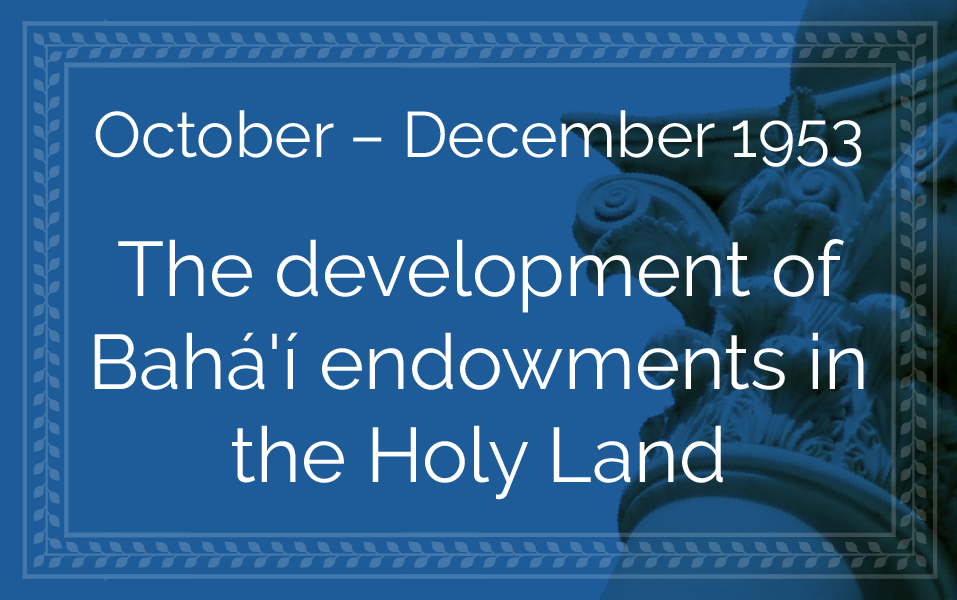
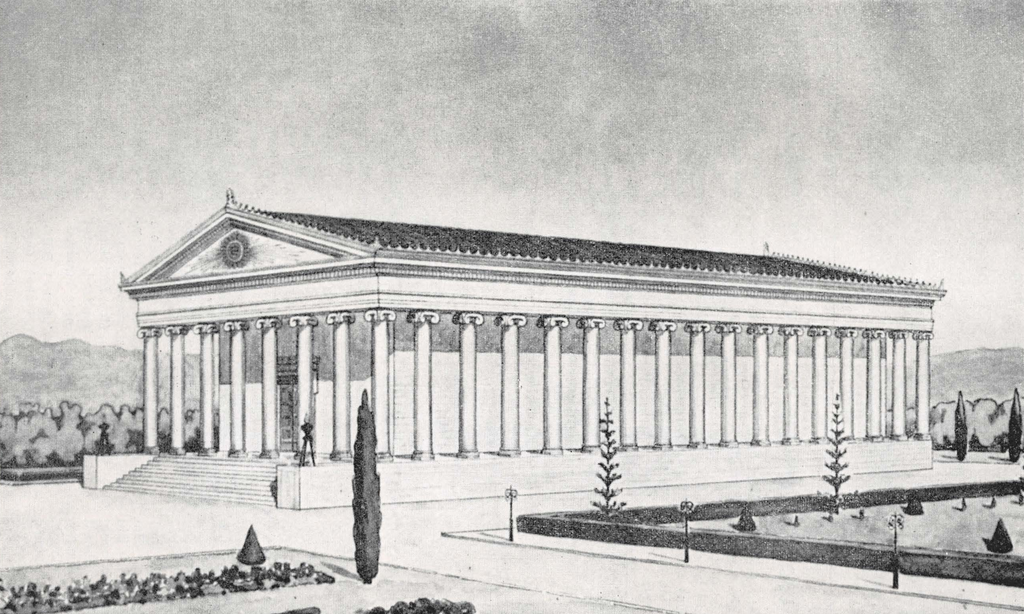
Water color painting of the Baha'i International Archives Building from the designs, 1955. Source: Bahaimedia.
When Hand of the Cause Mason Remey completed the design of the International Bahá'í Archives under the Guardian's guidance and supervision, the Guardian made the decision to officially unveil it at the New Delhi Intercontinental Teaching Conference in October 1953 and sent Hand of the Cause Ugo Giachery as his personal representative with a pen and ink rendering of the International Bahá'í Archives, which was placed each day at the front of the speakers' table.
The International Bahá'í Archives was a shining white building with a light green tiled roof, surrounded by Ionic columns on three sides, with small windows along the side and a stained glass window on the fourth side.
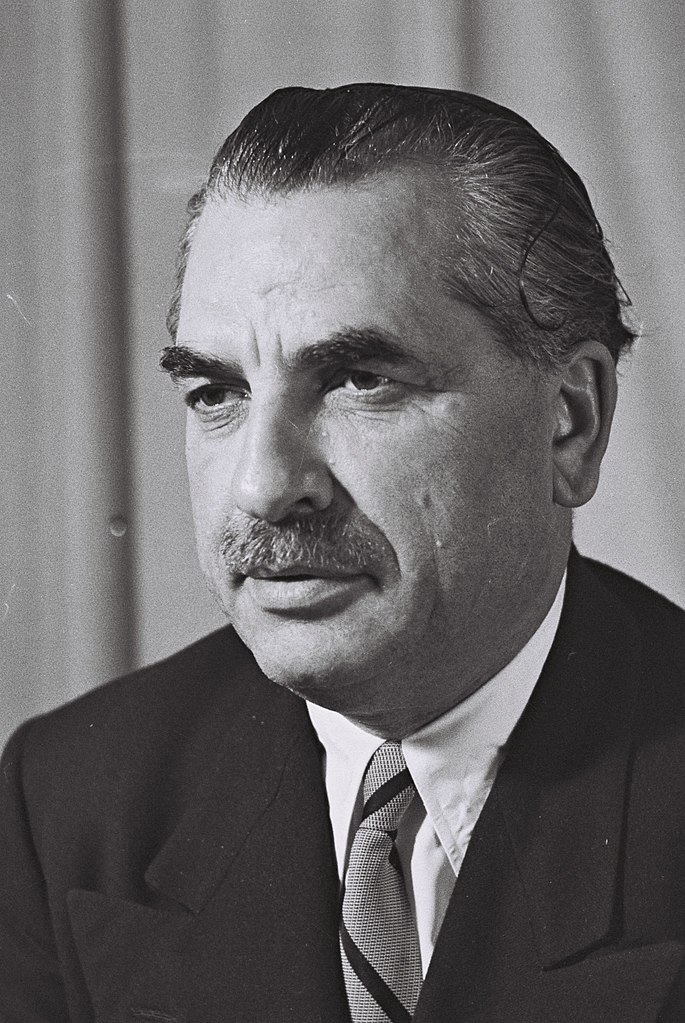
Haim-Moshe Shapira, the Minister of Religious Affairs of Israel’s fourth government from 1951–1958. Source: Wikimedia Commons.
With the creation of the State of Israel, the day-to-day dealings of the Bahá'í Community with the government in connection with its work at the Bahá'í World Centre, had been placed under the jurisdiction of the Ministry of Religious Affairs.
The Ministry of Religious Affairs was chiefly concerned with providing religious services to the Jews of Israel in cooperation with local authorities. As such, they provided financial assistance for religious studies, spread the teachings of the Torah, fostered the traditions of the Jewish way of life, maintained synagogues, protected Jewish holy sites, and managed rabbinical courts.
The Ministry also had what is now called a Religious Communities Division, created to deal with the millions of Druze, Muslim Christian, Samaritan and Karaite residents in Israel.
At first, the affairs of the Bahá'í community were handled by the same head of the Department that dealt with Muslim affairs.
The Guardian violently objected to this arrangement.
For the affairs of the Bahá'í Faith to be managed by the same person and the same Department that managed Islam heavily implied a similarity, or a correlation between the Bahá'í Faith and Islam when there was none.
After heavy negotiations, the Guardian prevailed.
On 13 December 1953, the Minister of Religious Affairs sent a letter addressed to "His Eminence, Shoghi Effendi Rabbani, World Head of the Bahá'í Faith" in which he said:
I am pleased to inform you of my decision to establish in our Ministry a separate Department for the Bahá'í Faith. I hope that this department will be of assistance to you in matters concerning the Bahá'í Centre in our State.
In the name of the Ministry of Religious Affairs of the State of Israel, I wish to assure Your Eminence that full protection will be given to the Holy Places as well as to the World Centre of the Bahá'í Faith.
The Guardian had just won a signal victory.
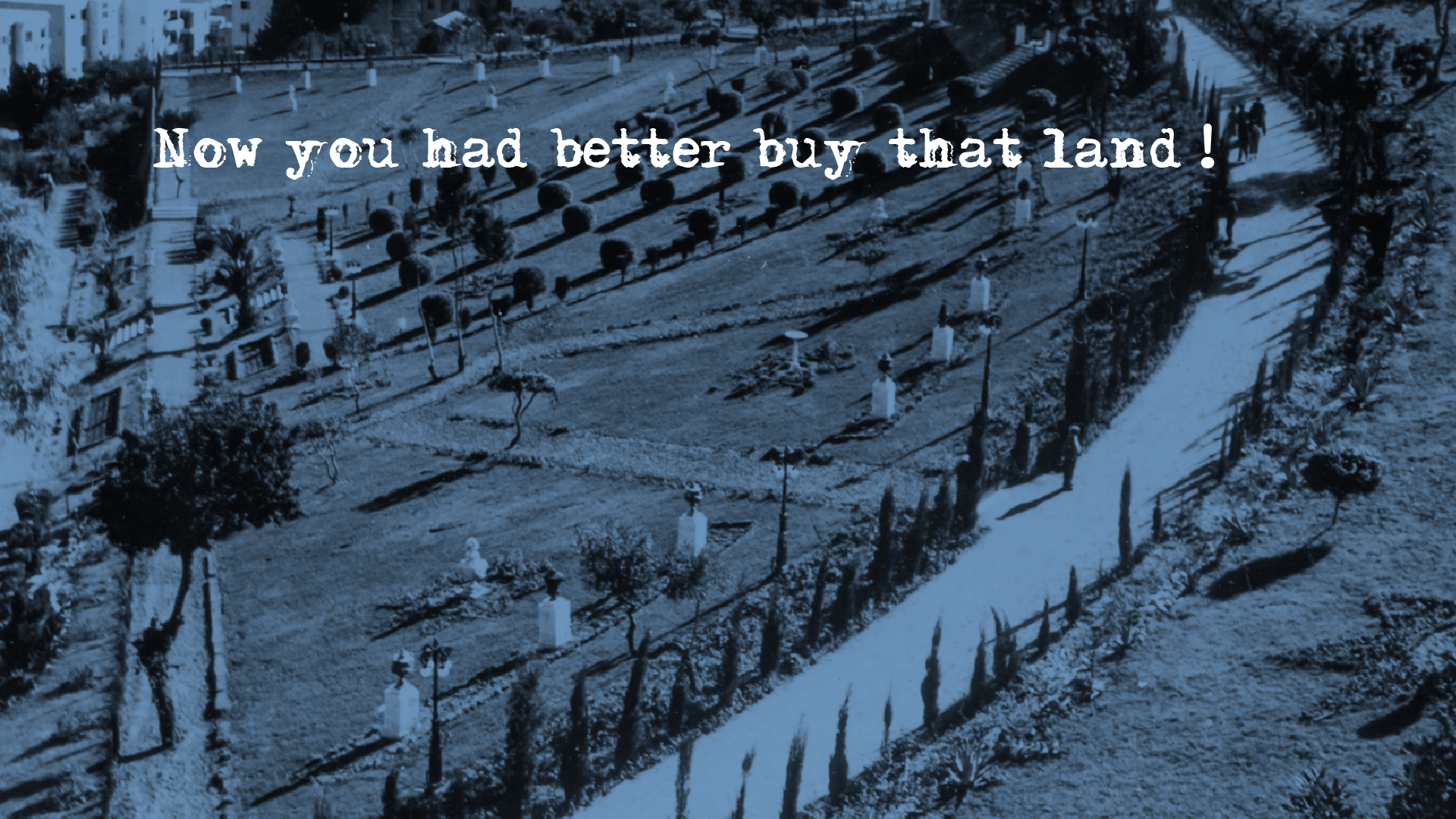
Background image: View of the Arc path and surrounding gardens, 1957. Source: Bahá'í Media Bank, © Bahá'í International Community 2023.
The Guardian had a crystal clear vision for the sweep of the Arc from north to South.
But the southern tip of Arc project was severely compromised because it was not owned by the Bahá'ís, and the piece of land was being held intact for the construction of a hotel for which plans had already been drawn up, but for which construction had not yet begun.
So, there was still reason to hope, and the Guardian asked Leroy Ioas to look into purchasing it.
Some time later the Guardian came to dinner and said to Leroy Ioas:
I've sent a cable today announcing the building of the Arc and the buildings around it.
Then he smiled and said to Leroy,
Now you had better buy that land!
The Guardian was abroad when it was finally purchased, but he cabled:
Tell Leroy deeply appreciate splendid achievement.
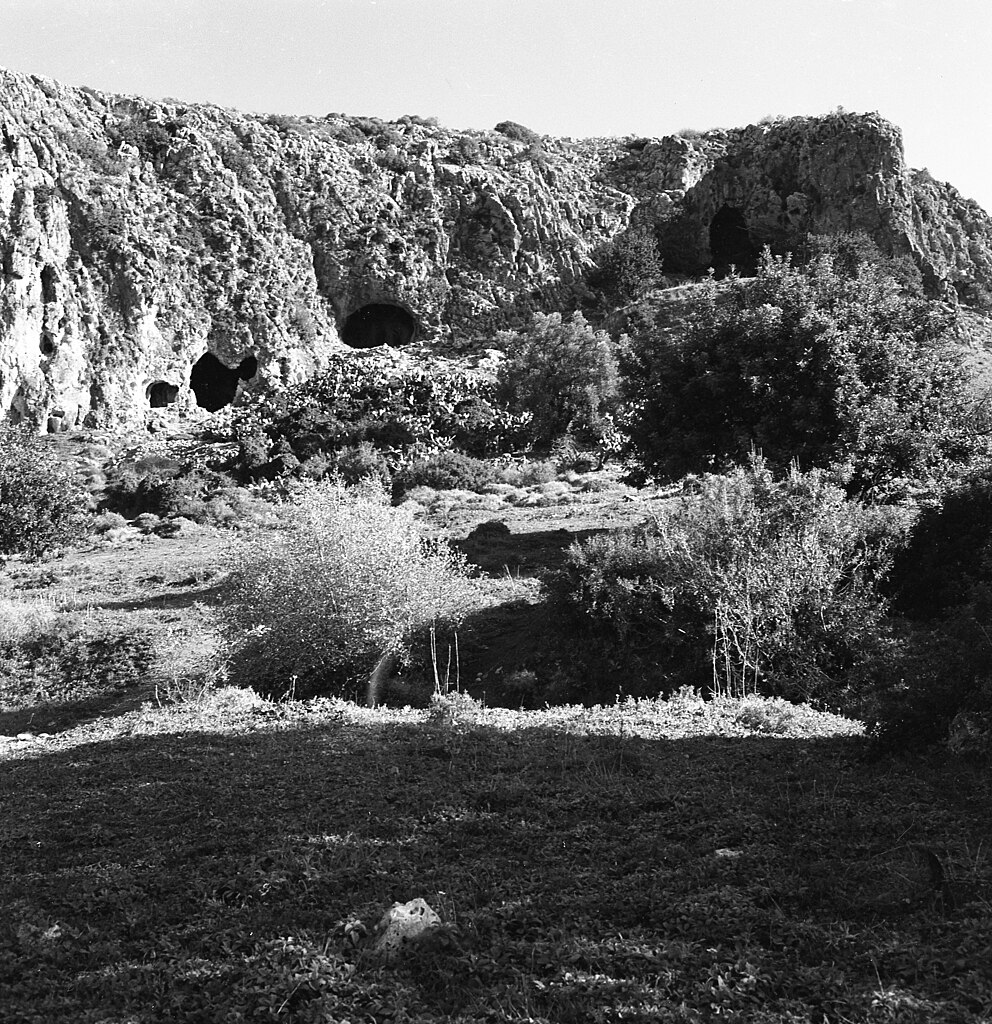
A virgin area of Mount Carmel. Source: Wikimedia Commons.
The Guardian and Leroy Ioas were not able to purchase every property they set their sights on, simply because they did not have unlimited funds.
A hotel was put up for sale on land that ran alongside the Bahá'í properties, and when Leroy Ioas informed the Guardian, he said:
We ought to own that property. But we don't have the money. Have you figured out what it would cost?
Yes, Shoghi Effendi, about a half million dollars.
The Guardian, who had a wonderful sense of humor and would occasionally tease Leroy Ioas—who took every word out of the Guardian’s mouth with utmost seriousness—remarked:
I bring a Hand of the Cause here to Haifa and then bankrupts the Cause.
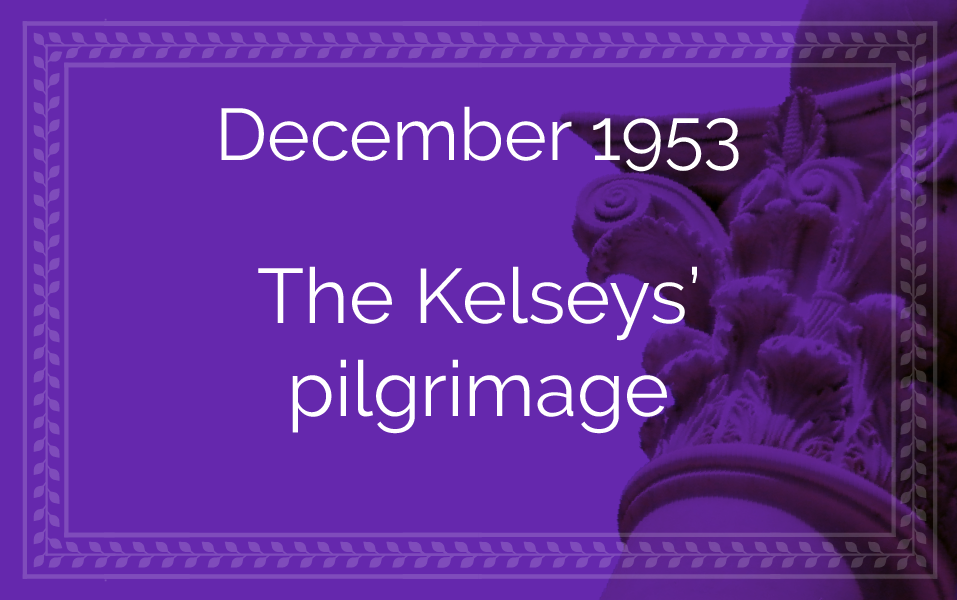
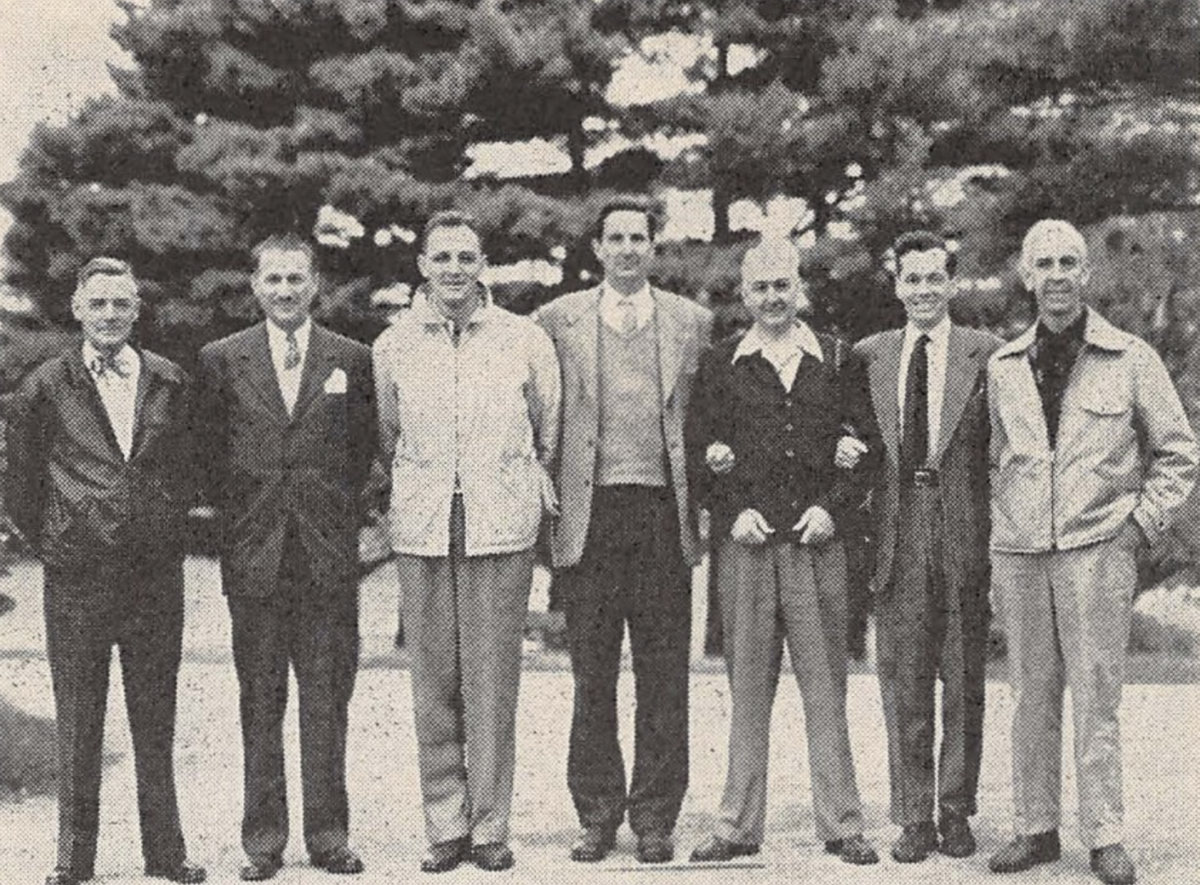
The Green Acre Development Committee from left to right: Lyle Hadden, Borrah Kavelin, David Ruhe, Robert McLaughlin, Stuart Sims, Lucien McComb, Curtis Kelsey. Source: Bahaimedia.
In early December 1953, Curtis was able to go on pilgrimage to Haifa with his wife Harriet. Their pilgrimage would last 26 days. For Curtis, the pilgrimage was coming home, it was a reunion, and Harriet felt the same way. She and Curtis had been married for 25 years since 1928, and his eight-month stay in Haifa between September 1921 and April 1922 had transformed him into the man she had fallen in love with. Through their marriage, Harriet had felt that profound spiritual effect vicariously, and at times, when she looked at, and could “feel” the Holy Land in him, so ingrained were his formative experiences there with 'Abdu'l-Bahá and the Guardian.
Curtis was astounded by the development of both Israel and the Holy Places in Haifa and Bahjí. He flew into a modern airport—in September 1921 he had arrived at a very primitive train station—Israel had flourished into a modern country with highways and tall buildings, Haifa was a bustling city—no longer the sleepy Palestinian town he had first known 30 years ago—and it boasted a gigantic shipping port.
But the Shrines!
The Queen of Carmel, the Shrine of the Báb hovered majestically over Haifa from its height on Mount Carmel, no longer 'Abdu'l-Bahá’s square, stone building he had first encountered, it was blinding white and shining gold, surrounded by verdure. His first thought was that 'Abdu'l-Bahá must be so happy.
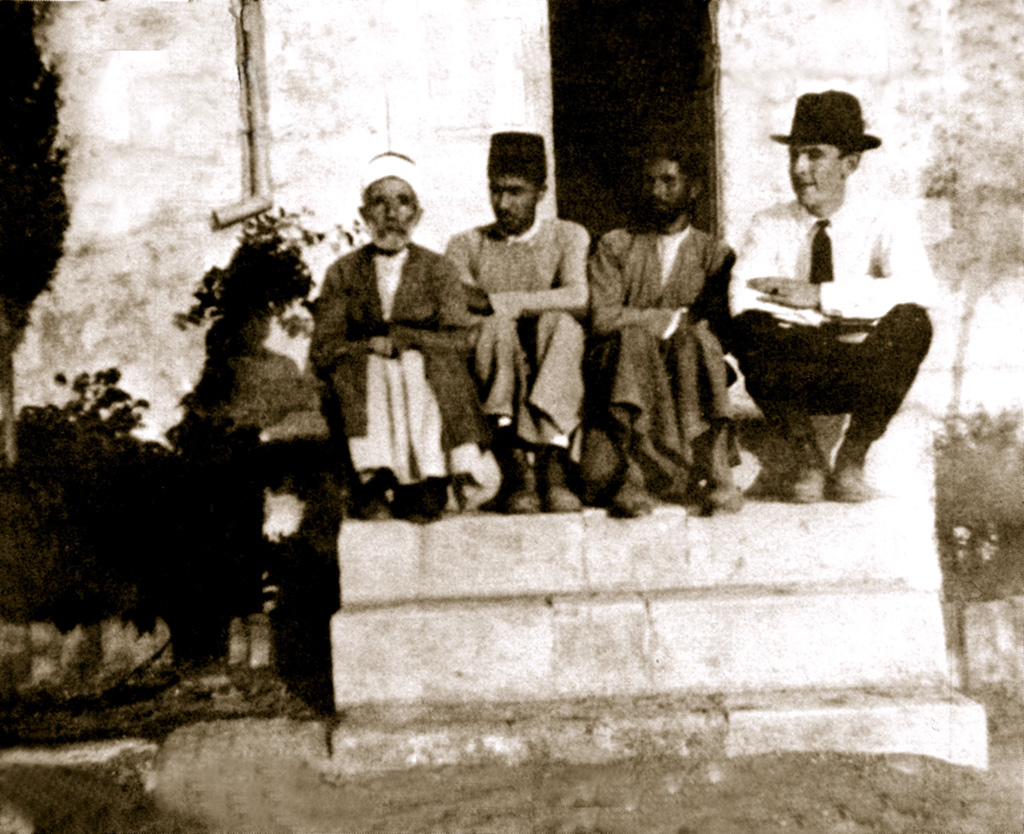
Curtis Kelsey sitting on the steps of the Baha'i Pilgrim House with some with resident Baha'is in October 1921, 32 years before his second pilgrimage. Source: Worldwide Community of Bahá'u'lláh.
Then Curtis finally met the Guardian. They had parted in early April 1922, 31 years ago, and the Guardian had changed considerably. Then, Shoghi Effendi had been 24 years old, and he was now he was 55, but that was not the change that moved Curtis the most.
Curtis was a very deepened believer and he absolutely knew that Shoghi Effendi would be scandalized by his inner thoughts, indeed, there is a good chance the Guardian would have found what he was thinking blasphemous, but Curtis Kelsey could not help himself. He had known 'Abdu'l-Bahá intimately in the two months he saw the Master almost every day between September and November 1921, and the Guardian just reminded him of 'Abdu'l-Bahá, in the way he spoke, the way he moved.
What moved Curtis even more, was the palpable power that radiated from the Guardian. It was the same power Curtis had felt emanating from 'Abdu'l-Bahá, perhaps the power that was associated with the Center of the Covenant, the Protector of the Faith, flowed through the World Head of the Bahá'í Faith, its first defender. Perhaps it was the power of the Covenant. Curtis felt, beyond the shadow of a doubt that God walked closely with Shoghi Effendi.
One thing in the Guardian that had not changed, was the youthful sparkle in Shoghi Effendi’s eyes, the very manifestation of his innate purity and sense of joy.

No photographs were found of the water pump at Bahjí. This is the water pump at the Riḍván Garden, in the 1920s. Source: Bahá'í Media Bank, © Bahá'í International Community 2023.
Like his mother, Valeria DeMude Kelsey, a staunch Bahá'í who had declared 18 years before him, Curtis felt that the Holy Land was his home, and almost as soon as he arrived, he felt a sense of dread at the idea of leaving in 9 short days. Still, he knew that the Bahá'í work in the United States was critically important for the Guardian and he made his peace. In truth, Curtis wanted to stay in Haifa forever, at the side of the Guardian, and where his Beloved 'Abdu'l-Bahá had lived, and where He was buried.
Midway through the Kelsey’s pilgrimage, the Guardian invited Harriet and Curtis to stay an extra three weeks. He needed Curtis to coordinate the installation of a water pump at Bahjí.
Curtis was ecstatic, to say the least.
He was back in his familiar work clothes, again, he was working on beautifying the Holy Places, again, he was offering the Guardian an important and direly needed service, again.
Working for the Bahá'í Faith in the Holy Land was, in a sense, Curtis Kelsey’s true home, and it had been for 31 years.

Curtis Kelsey (Bahá'í Blog) and his wife Harriet Morgan Kelsey (Bahaimedia).
Curtis and Harriet’s 26 days at the Bahá'í World Centre were a heavenly experience. They spent time with the Guardian at dinner every night, speaking with him about the progress of the Teaching work in the Ten Year Crusade, and Curtis remembered how he had spent time speaking to 'Abdu'l-Bahá about the Faith as well, three decades before, but with the Guardian, there was a lifeblood, an energy, a vitality when he spoke about the unfoldment of Bahá'u'lláh’s Administrative Order, the victories in the field, the unfoldment of the Crusade. Curtis couldn’t help but thinking he was watching a divine General, commenting on the unfolding victory of a worldwide campaign.
For Harriet Kelsey, the high point of their pilgrimage was when the Guardian turned to her at dinner one night and said:
You and Curtis should be proud of the fact that all of your children are Bahá’ís; that had not even happened to the Holy Family.
For Harriet, the Guardian could not have paid her a higher compliment, he could not have bestowed on her a greater honor.
This was the last time Curtis and Harriet would ever see the Guardian alive.
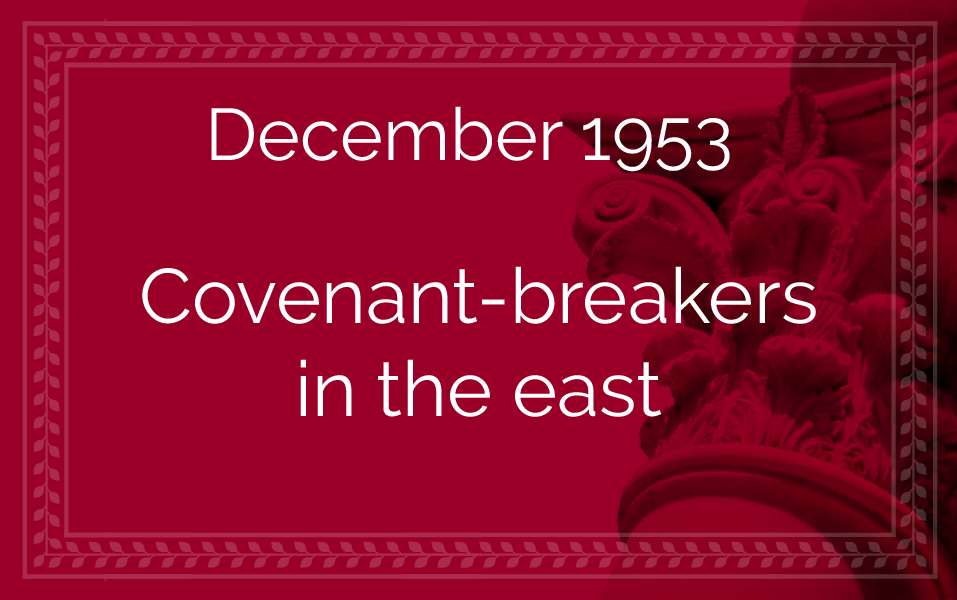

Avárih had gotten involved with politics, and after being shunned as a Covenant-breaker by the Bahá'í community, he now fell into disgrace in the eyes of his fellow-Muslims, and the Persian government exiled him from Ṭihrán to Yazd, where he lived an absolutely miserable life.
Shoghi Effendi had predicted that Avárih would live to a ripe old age and would witness with his own eyes the progress of the Faith he had worked so hard and failed so shamefully to destroy.
Avárih saw the Faith turn 100 with majestic worldwide Centennials.
He saw the launch of the Guardian’s Ten Year Crusade.
He saw the completion of the majestic, superb, superstructure of the Shrine of the Báb, the Queen of Carmel, shining in gold above the blue Mediterranean.
He saw the Centenary of Bahá'u'lláh’s Revelation in the Siyáh-Chál and the worldwide year-long celebrations during the Holy Year.
He saw the Faith penetrate the remotest corner of the globe.
He not only witnesses the glory of the Faith, the unity of the Bahá'í community, but the guiding hand of the Guardian behind each of these stupendous victories.
Avárih died in Yazd in 1953, at the age of 82, after witnessing these momentous, joyful, events in the history of the FaithAfter his death, Shoghi Effendi sent the following cable on 16 December 1953 to the Bahá'í world:
[Avárih] will be condemned by posterity as being the most shameless, vicious, relentless apostate in the annals of the Faith, who, through ceaseless vitriolic attacks recorded in voluminous writings and close alliance with its traditional enemies, assiduously schemed to blacken its name and subvert the foundations of its institutions.
The Guardian mentions something very profound in the second part of this cable. He says that Avárih, and the other two Covenant-breakers who had died around the same time as him—Fareed and Falah, “however blinded by perversity, could not have failed to perceive, as their infamous careers approached their end, the futility of their opposition, the measure of their own loss and the degree of progress and consolidation of the triumphant administrative order so magnificently celebrated in the course of the festivities of the recently concluded Holy Year.”
In one of his letters to the Bahá'ís of Persia who had stood fast in the face of Avárih and completely ignored him, the Guardian compared Avárih to a dead body, which the surging Ocean of the Faith of Bahá'u'lláh had thrown up onto the shore, cleansing itself from its pollution.

There were other Covenant-breakers active in Persia and Egypt during the Guardian’s ministry. To not give them weight in this chronology, we will just name them: Dr Ameen Fareed was Munírih Khánum’s nephew. When traveling with 'Abdu'l-Bahá in America he had forged the Master’s signature and taken money from the Bahá'ís. He made 'Abdu'l-Bahá suffer tremendously. Ḥasan-i-Nikú was a close friend of Avárih who attacked the Faith with bitter hateful books. Faydu’llah Subhi was an associate of Avárih who lived his entire life in the stain of Covenant-breaking. Fa’iq was an Armenian Covenant-breaker living in Egypt who tried to create a sect of the Bahá'í Faith called “Scientific Society.” It was, of course, a miserable failure. Falah lived in İskenderun, Turkey. He infected his relatives with Covenant-breaking and was unrepentant until the end of his life.
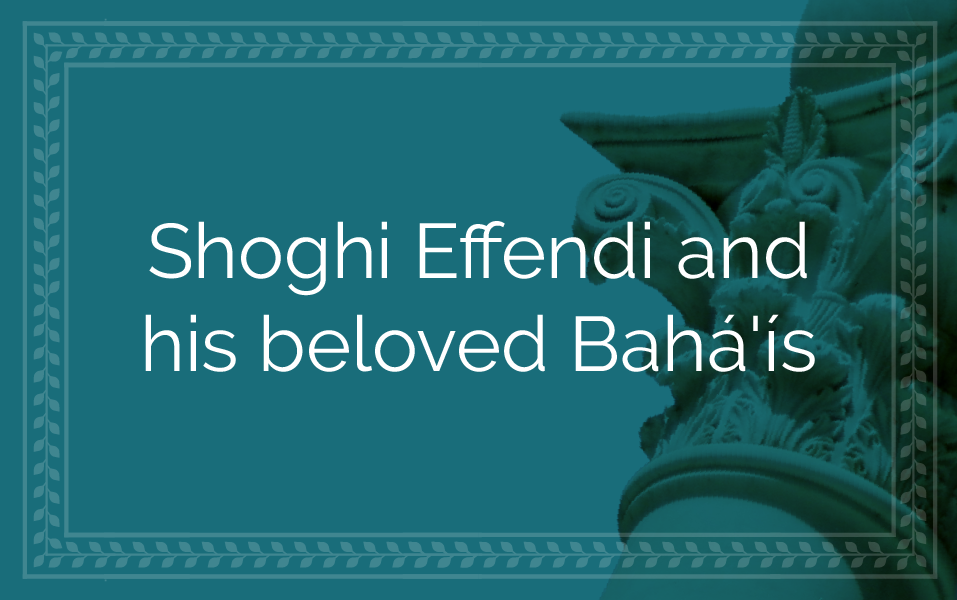
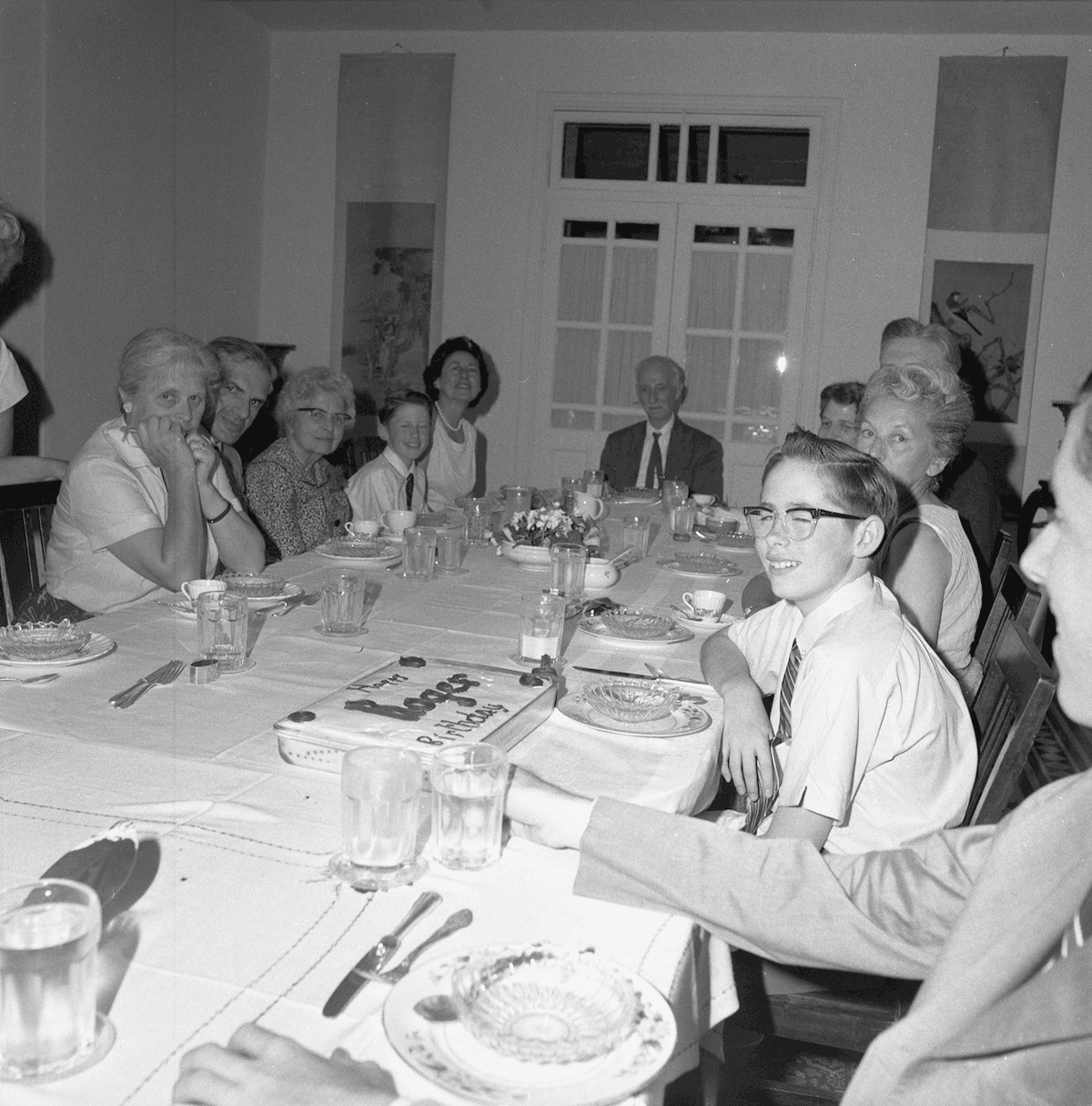
Dinner at the Western Pilgrim House in 1960. Hand of the Cause Horace Holley is sitting at the head of the table. (in the photograph in part 19, Doris Holley is seated at the other end). To his right and on the left of the picture for us are Joyce Dahl and her son Greg. Sitting next to Greg is Jessie Revell, and to her right is Hand of the Cause John Ferraby. The birthday cake in the center of the photograph is in front of Roger Dahl, another son of Joyce and Arthur Dahl. Next to Roger Dahl is Marjorie Haney sitting next to her husband Hand of the Cause Paul Haney whom we can only see the head of. Photograph taken by Arthur L. Dahl, and part of the © Gregory C. Dahl collection, used with permission for non-commercial purposes. Detailed caption provided by Gregory C. Dahl. Source: Gregory C. Dahl.
When the pilgrims entered the dining room at the western Pilgrim House, Shoghi Effendi and Rúḥíyyih Khánum were already there. Shoghi Effendi often wore his signature outfit: a light tan camel's hair coat, a white shirt with a black tie and a black fez. He had warm tan skin and deeply expressive brown eyes, and at the age of 57, he only had a few grey hairs. The Guardian was short in stature, but his presence filled the room with energy, he had a beautiful voice and spoke the most exquisite English.
The Guardian was loving and tender with the pilgrims, often asking about their families and sending his regards, and pilgrim after pilgrim stated that the Guardian always knew what was in their mind and in their hearts, he seemed to answer questions before they were asked.
Hand of the Cause Dhikru’lláh Khadem once said:
The beloved Guardian knows the heart of each one of us.
At dinner, the Guardian spoke on his favorite topic: the heroic achievements of the worldwide Bahá'í community.
He never mentioned himself, even though he was the Captain of the ship, the one spurring on the Bahá'ís to give more, and win greater victories. The Guardian was deeply humble, just like his Grandfather 'Abdu'l-Bahá.
The Guardian’s voice was a thing of marvel. He modulated it depending on what he was speaking about, and it conveyed awe, respect, but also firmness, which was the tone he employed whenever he was speaking about the Administrative Order of the Faith of Bahá'u'lláh.
Like 'Abdu'l-Bahá, Shoghi Effendi had a delightful sense of humor and loved to make the pilgrims laugh by regaling them with funny stories and amusing incidents, and when he did, his eyes twinkled.
The one thing that made the Guardian the happiest was unity between the Bahá'ís. then his eyes twinkled as he laughed. Nothing made Shoghi Effendi happier than news of the unity among the believers.
Some evenings, if something particularly amazing had taken place, the Guardian would share the news with the pilgrims. He had no secrets except for utterly confidential matters. But sometimes, he also stayed after dinner to deepen the pilgrims on an aspect of Bahá'u'lláh’s Teachings.
After Shoghi Effendi retired, Rúḥíyyih Khánum would entertain the pilgrims in the sitting room of the western Pilgrim House.
If Bahá'ís asked for Shoghi Effendi’s advice, he freely gave it, and it was sometimes very specific. Once he told a pilgrim who had asked if she could render him a service:
Please visit the Bahá'í pioneers on the islands in the Mediterranean and give them my love, cheer them up, and beg them to remain at their posts; for if they leave, those who come to replace them will find it much more difficult. Share with them the spirit of the Holy Places here, particularly that of the Sacred Shrines, and tell them of the latest developments of the Ten Year Crusade.
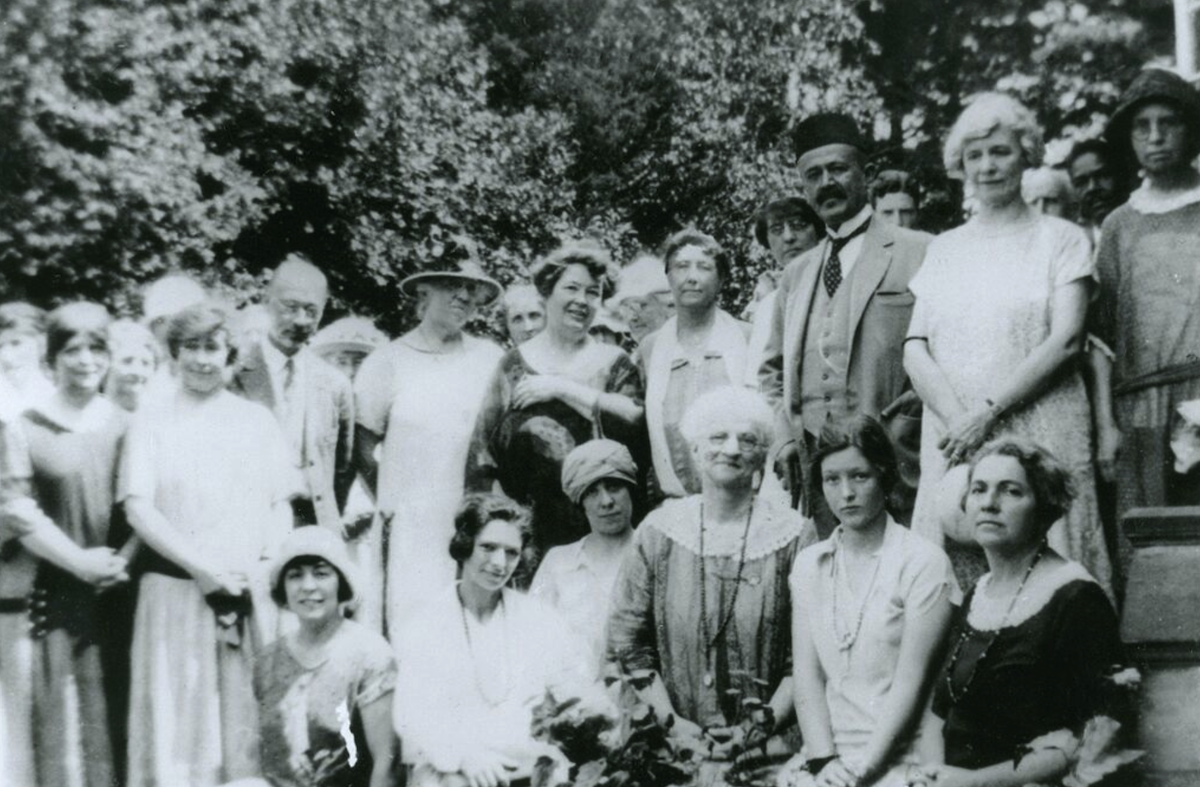
Baha'is who were later named Hands of the Cause of God are pictured at Eliot, Maine, United States, around 1926, when Marion Jack (standing center in dark gown) was present. Those later elevated to the rank of Hand of the Cause include Mary Maxwell (later Hand of the Cause Amatul'Bahá Ruḥíyyíh Khánum), seated second from the right; Paul Haney (partially obscured in back row to the right of man in eastern-style hat); Louis Gregory, standing second from right next to his wife, Louisa, who was the first Baha'i pioneer to Bulgaria. May Maxwell, a prominent Baha’i and mother of Mary Maxwell, stands at the left in dark gown with hands together. Physician and educator Dr. Susan Moody is seated to the left of Mary Maxwell. Stanwood Cobb, a Baha'i author, is wearing a suit and is standing near the left of the group. Source: Bahaimedia.
Shoghi Effendi was so loving and so flexible, and so caring, that sometimes, faced with the ardor and passion of a pioneer, even his initial directives could change.
Marion Jack, whom 'Abdu'l-Bahá had called “General Jack,” was a true Bahá'í heroine. In fact, Shoghi Effendi called her an “immortal heroine,” and stated that, apart from Martha Root, no one came close to Marion Jack in terms of “Constancy, dedication, self-abnegation, fearlessness."
Marion Jack was pioneering in Sofia, Bulgarian when World War II broke out and the Guardian was concerned about her safety, so he wired:
Advise return Canada wire whether financially able,
Marion Jack replied:
…how about Switzerland…
Shoghi Effendi wired back:
Approve Switzerland.
Marion Jack really did not want to leave her pioneer post, and she begged the Guardian to allow her to stay.
Shoghi Effendi replied:
Advise remain Sofia love.
Speaking of Marion Jack and Martha Root in 1940, Shoghi Effendi would say:
You cannot be a hero without action. This is the touchstone. Not movement, coming and going, but in the evidences of your character. Jacky [Marion Jack] is a heroine because of her conduct, the heroic spirit reveals itself in her. Martha [Martha Root] had the heroic action. She went 'til she dropped.
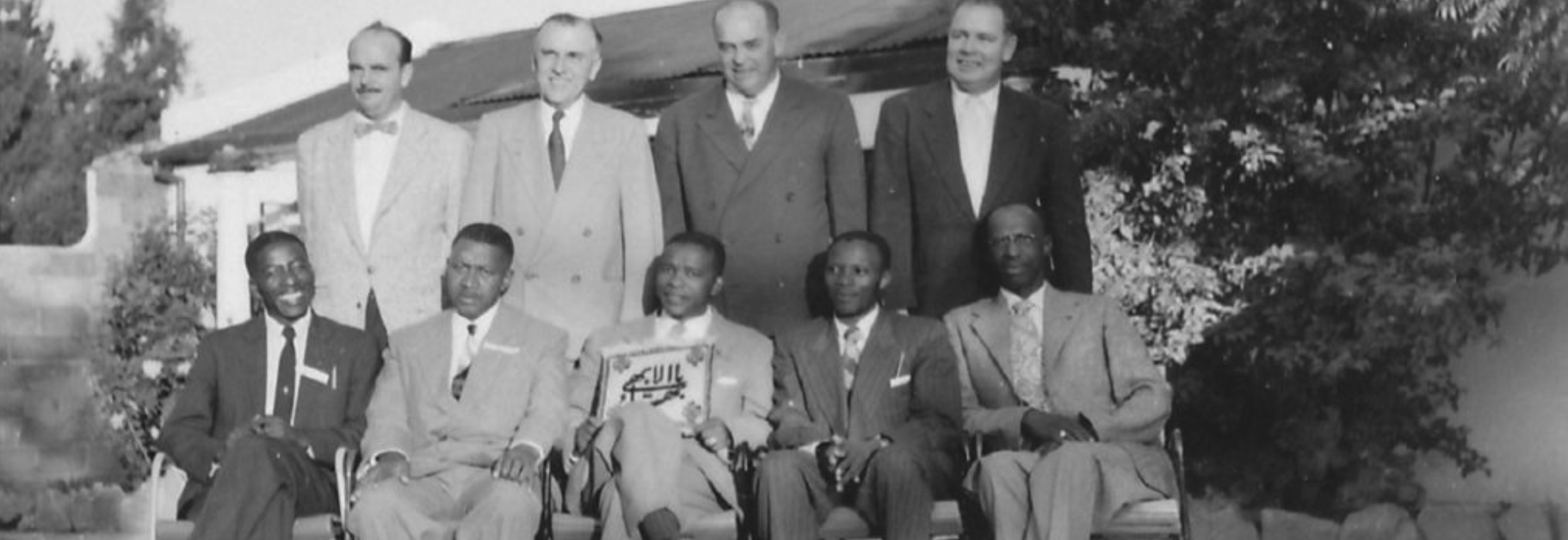
The National Spiritual Assembly of the Bahá’is of South and West Africa, Ridvan 1956 with 5 African Bahá'ís. Source: Bahaimedia.
Shoghi Effendi loved indigenous people with all his heart, and he instinctively knew how to reach them. One day, a Canadian woman who as on pilgrimage explained that the Bahá'ís in her country were struggling with teaching Inuit, the indigenous peoples of the Arctic.
The main cultural gap was that Inuit had a difficult time grasping the similes in the Bahá'í Writings, which referred to things they had never seen in their day-to-day lives, such as nightingales and roses. These were utterly foreign, unknown to them in a way they could not connect.
The Guardian’s reaction was incandescent, so typical of his loving, empathic and understanding nature. When the pilgrim was leaving, Shoghi Effendi bid her farewell, and gave her a small vial of Persian attar of rose.
Attar of rose is a 5,000-year-old essential oil where thousands and thousands of fragrant roses of different varietals are picked by hand, before sunrise. The rose petals are plucked, and distilled in huge copper tanks, and the intensely aromatic vapor is collected into vials. Attar of rose is, in fact, the essence of rose, and that was what Shoghi Effendi was giving the Canadian Bahá'í to present to Inuit peoples. He told the woman to anoint Inuit with the attar of rose, and that, perhaps in this way, they would feel what Bahá'u'lláh had meant when He wrote of the rose.
Shoghi Effendi’s heart belonged to all indigenous people. He spoke about the importance of teaching Māori In a letter dated 27 June 1957, written by Rúḥíyyih Khánum on behalf of the Guardian, he gave advice to the newly-elected National Spiritual Assembly of New Zealand:
As you formulate your plans and carry them out for the work entrusted to you during the next six years, he wishes you to particularly bear in mind the need of teaching the Maoris. These original discoverers of New Zealand are of a very fine race, and they are a people long admired for their noble qualities; and special effort should be made, not only to contact the Maoris in the cities, and draw them into the Faith, but to go to their towns and live amongst them and establish Assemblies in which at least the majority of the believers will be Maoris, if not all. This would be indeed a worthy achievement.
To a Mongol pilgrim, the Guardian explained that, just like the majority of earth’s population was not white, neither should the Bahá'ís, and that the membership of the Bahá'í community should reflect the population of the world.
Of course, Shoghi Effendi made statement regarding countless of indigenous populations throughout the entire world, on every continent, our examples have ranged so far from North, Central and South America, the Arctic, Central Asia, and this last letter, written on behalf of the Guardian to the National Spiritual Assembly of North West Africa deals with an indigenous North African tribe, Berbers:
As he has mentioned many times to pilgrims and in his communications to friends in North Africa, he wishes special attention paid in that area to the Berbers. Indeed every effort should be made to enroll as many Berber minorities in the Faith as possible, as well as the other races among the inhabitants of the country.

Participants at Native American program at Geyserville Summer School, 1957. Source: Bahaimedia.
In the same way that Bahá'u'lláh and 'Abdu'l-Bahá, throughout their respective ministries, singled out the poor and downtrodden, Shoghi Effendi also paid particular attention to the suffering of indigenous communities worldwide. 'Abdu'l-Bahá had emphasized that Bahá'ís should be cared for, educate and guide Native Americans.
Shoghi Effendi never forgot 'Abdu'l-Bahá’s care of the indigenous population of America, and throughout his Guardianship, he repeatedly urged the North American Bahá'ís to make special effort to teach them the Faith.
In some of his last letters to various National Spiritual Assemblies in the western World, Shoghi Effendi stressed the importance of teaching Native Americans.
This is a letter dated 28 July 1957, written on behalf of Shoghi Effendi to the National Spiritual Assembly of Central America and Mexico, four months before his passing. A note on terminology: at the time the Guardian wrote these words, it was considered perfectly acceptable to use the word “Indian” where we today speak of indigenous or Native populations. In this letter, Shoghi Effendi expresses empathy for a generationally-abused minority:
…special attention must be focused on the work of converting the Indians to the Faith. The goal should be all-Indian Assemblies, so that these much exploited and suppressed original inhabitants of the land may realize that they are equals and partners in the affairs of the Cause of God, and that Bahá'u'lláh is the Manifestation of God for "them."
In another letter from July 1957 and written on his behalf to one of the National Spiritual Assemblies of Latin America, the Guardian highlighted an event he found great joy in: the presence of indigenous Bahá'ís at National convention, and referred to his Grandfather’s statement regarding their spiritual potential:
He was particularly happy to see that some of the Indian believers were present at the Convention. He attaches the greatest importance to teaching the original inhabitants of the Americas the Faith. 'Abdu'l-Bahá Himself has stated how great are their potentialities, and it is their right, and the duty of the non-Indian Bahá'ís, to see that they receive the Message of God for this day. One of the most worthy objectives of your Assembly must be the establishment of all-Indian Spiritual Assemblies.
In the same letter, Shoghi Effendi gives advice on the National Spiritual Assembly’s goal, which should include paying loving and dedicated attention to humble people in isolated centers, by reflecting on these people’s brilliant history in the annals of the Faith:
[The Bahá'ís] must be encouraged by your Assembly to remember that small people, often poor and obscure people, have changed the course of human destiny more than people who started out with wealth, fame and security. It was the Sifter of Wheat who, in the early days of our Faith, arose and became a hero and martyr, not the learned priests of his city!
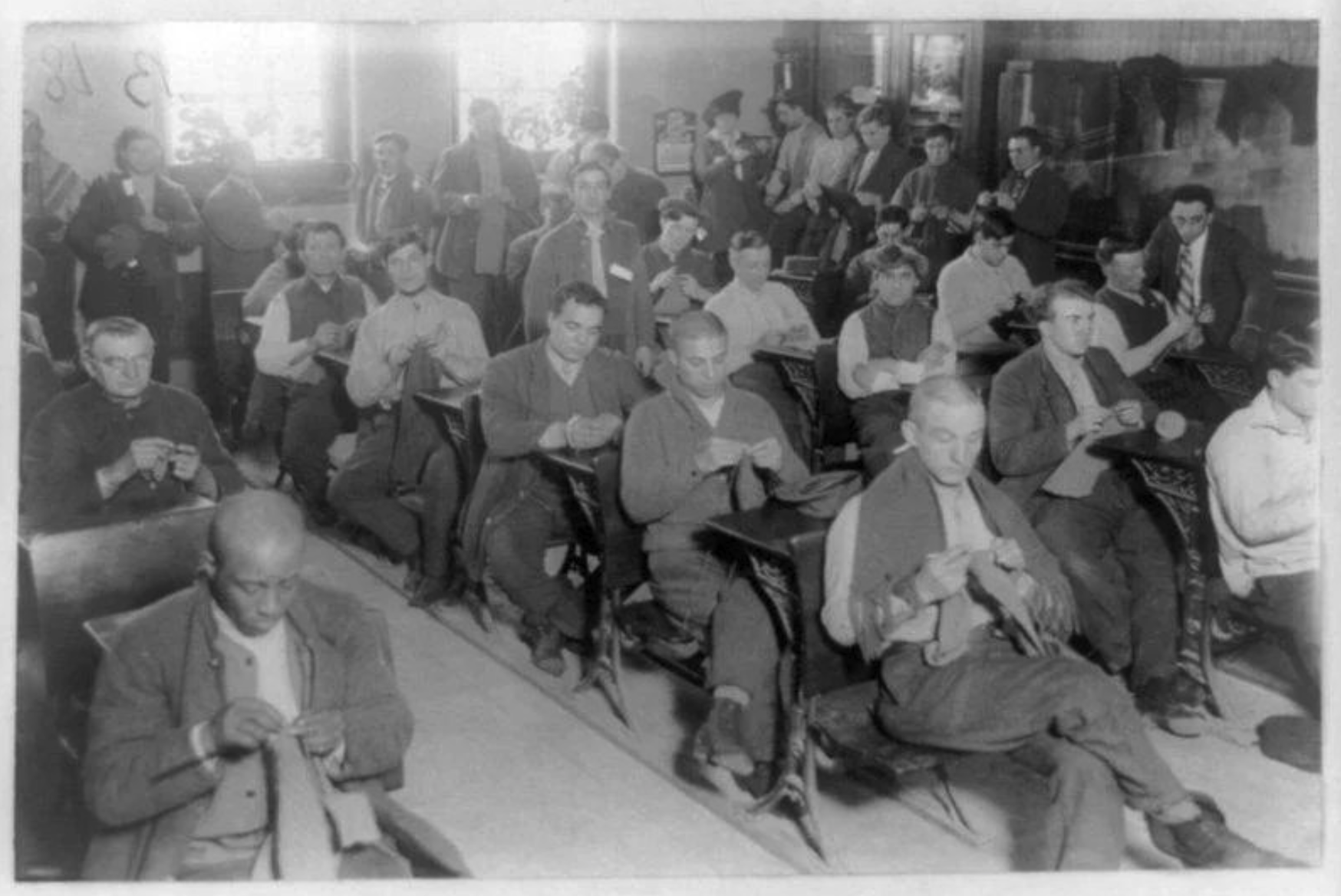
Prisoners knitting socks for soldiers at Sing Sing 1915. Source: Wikimedia Commons.
Of course, because the Guardian was constantly and unerringly guided by divine forces, his unique, matchless perspective was one of the most important facets of his station. It allowed him to consistently expand the understanding of everyone around him, from his wife, Rúḥíyyih Khánum, to pilgrims and coworkers, long-standing and newly-declared Bahá'ís, through his words, his reactions and his example.
The perfect example of this was the Guardian’s lengthy Riḍván message of 1957. Among many other victories of the Faith that year, he mentioned the list of the number of virgin territories and islands opened to the Faith, the number of Local Spiritual Assemblies, the number of localities where Bahá'ís lived, the geographic spread of the Faith on the planet, the number of languages in which the Faith’s literature has been translated, the number of local Bahá'í centers, the number of countries, states, districts and territories recognizing Bahá'í marriage, and those recognizing Bahá'í Holy Days.
It was in relationship to the last point, the places having recognized Bahá'í Holy Days, that the Guardian mentioned something absolutely astonishing:
The number of countries, states as well as cities of the United States, where the Educational Authorities have recognized the Bahá'í Holy Days now exceeds forty-five, among which are included Israel, the British Isles, Samoa, Liberia, Tanganyika, the states of Victoria and of South Australia. Mention in this connection, moreover, should be made of the recognition officially extended by the authorities of H. M. Kitalya Farm Prison in Uganda to its recently converted Bahá'í inmates to observe these same Holy Days.
The Guardian felt Many Bahá'ís would have felt a certain amount of shame at saying that Bahá'ís were incarcerated. But not the Guardian. He felt pride that inmates of a Ugandan prison converted to the Bahá'í Faith. Rúḥíyyih Khánum emphatically states that if he had not been proud of this, he never would have included it.
This was a cornerstone of the Guardian’s beliefs.
He often told pilgrims that the Bahá'í Faith was for everyone. All men deserved the Faith, sinners just as much as saints.
Two principles guided this.
First, society must be governed and protected by laws, laws which punish those who break them, sometimes sending them to prison.
Second, everyone must have the chance to believe in Bahá'u'lláh. Faith is the spark that enkindles a person’s soul and guides it to an everlasting awareness of the bounty of God. Every single person on earth, whether in prison or not, has the right to Faith, regardless of their crime or sins.
In several letters, at different points in his ministry, the Guardian encouraged Bahá'ís to teach in prisons here are three short excerpts.
This first letter, an exceptional one, is from Shoghi Effendi to a British inmate, dated 8 April 1948. In this letter, the Guardian gives profound life advice to this prisoner, speaking about faith, laws, justice, attitude, bitterness, forgiveness, and eventually, atonement and a possible future:
You have already, through at last facing yourself and acknowledging that you have both failed and erred in managing your life so far, set your feet on the right path. But now this new and spiritual condition in you is going to be proved - and the proving, the testing, will surely consist of the way you determine to take your punishment. Life is based on laws: physical, man-made, and spiritual. As you have broken the laws of the society in which you live, you will have to stand up like a man and take your punishment. The spirit in which you do this is the most important thing, and constitutes a great opportunity for you…at present, until your sentence is up, you must live within yourself in a way not to spoil the new future awaiting you. You must not become bitter—for after all you are only reaping what you planted. Bahá’u’lláh and ‘Abdu’l-Bahá through no crime of their own, spent the better part of their lives in exile and imprisoned, but they never became embittered although they were the victims of injustice. You, on the other hand, are the victim of injustice which you have inflicted on yourself— therefore you certainly have no right to be bitter towards the world. He urges you to grasp firmly the teachings of our Faith, the love of your family and many Bahá’í friends, to put the past behind entirely, realizing that it can do you no more harm; on the contrary, through changing you and making you spiritually aware, this very past can be a means of enriching your life in the future!
The second one is from a letter by Shoghi Effendi to the Spiritual Assembly of Honolulu, dated 23 April 1955, where he speaks about acceptance and forgiveness:
Also there is no reason why a prisoner should not be accepted as a declared believer on the same basis as anybody else. They are now expiating their crime against society, and, if their hearts have changed, and they accept the Cause, there is no reason why they should be excluded from membership.
The third one is a letter from Shoghi Effendi dated 5 August 1955 and addressed to the British Bahá'ís. In this letter, the Guardian brings up an important point, of not having a blanket rule, but evaluating each case on an individual basis:
A prisoner, showing sincere faith in the Cause, may be accepted as a Bahá’í on the same basis of investigating his qualifications as to belief as any other individual outside prison. Each case should be carefully considered on its own merits. Naturally, a person in confinement cannot be active in any community and administrative work. When he gets out, he becomes part of the community in which he resides. No new ruling is required in this matter. All other details in relation to prisoners can be decided by the National Spiritual Assembly concerned as they arise.
In several letters, at different points in his ministry, the Guardian encouraged Bahá'ís to teach in prisons here are three short excerpts.
This first letter, an exceptional one, is from Shoghi Effendi to a British inmate, dated 8 April 1948. In this letter, the Guardian gives profound life advice to this prisoner, speaking about faith, laws, justice, attitude, bitterness, forgiveness, and eventually, atonement and a possible future:
You have already, through at last facing yourself and acknowledging that you have both failed and erred in managing your life so far, set your feet on the right path. But now this new and spiritual condition in you is going to be proved - and the proving, the testing, will surely consist of the way you determine to take your punishment. Life is based on laws: physical, man-made, and spiritual. As you have broken the laws of the society in which you live, you will have to stand up like a man and take your punishment. The spirit in which you do this is the most important thing, and constitutes a great opportunity for you…at present, until your sentence is up, you must live within yourself in a way not to spoil the new future awaiting you. You must not become bitter—for after all you are only reaping what you planted. Bahá’u’lláh and ‘Abdu’l-Bahá through no crime of their own, spent the better part of their lives in exile and imprisoned, but they never became embittered although they were the victims of injustice. You, on the other hand, are the victim of injustice which you have inflicted on yourself— therefore you certainly have no right to be bitter towards the world. He urges you to grasp firmly the teachings of our Faith, the love of your family and many Bahá’í friends, to put the past behind entirely, realizing that it can do you no more harm; on the contrary, through changing you and making you spiritually aware, this very past can be a means of enriching your life in the future!
The second one is from a letter by Shoghi Effendi to the Spiritual Assembly of Honolulu, dated 23 April 1955, where he speaks about acceptance and forgiveness:
Also there is no reason why a prisoner should not be accepted as a declared believer on the same basis as anybody else. They are now expiating their crime against society, and, if their hearts have changed, and they accept the Cause, there is no reason why they should be excluded from membership.
The third one is a letter from Shoghi Effendi dated 5 August 1955 and addressed to the British Bahá'ís. In this letter, the Guardian brings up an important point, of not having a blanket rule, but evaluating each case on an individual basis:
A prisoner, showing sincere faith in the Cause, may be accepted as a Bahá’í on the same basis of investigating his qualifications as to belief as any other individual outside prison. Each case should be carefully considered on its own merits. Naturally, a person in confinement cannot be active in any community and administrative work. When he gets out, he becomes part of the community in which he resides. No new ruling is required in this matter. All other details in relation to prisoners can be decided by the National Spiritual Assembly concerned as they arise.
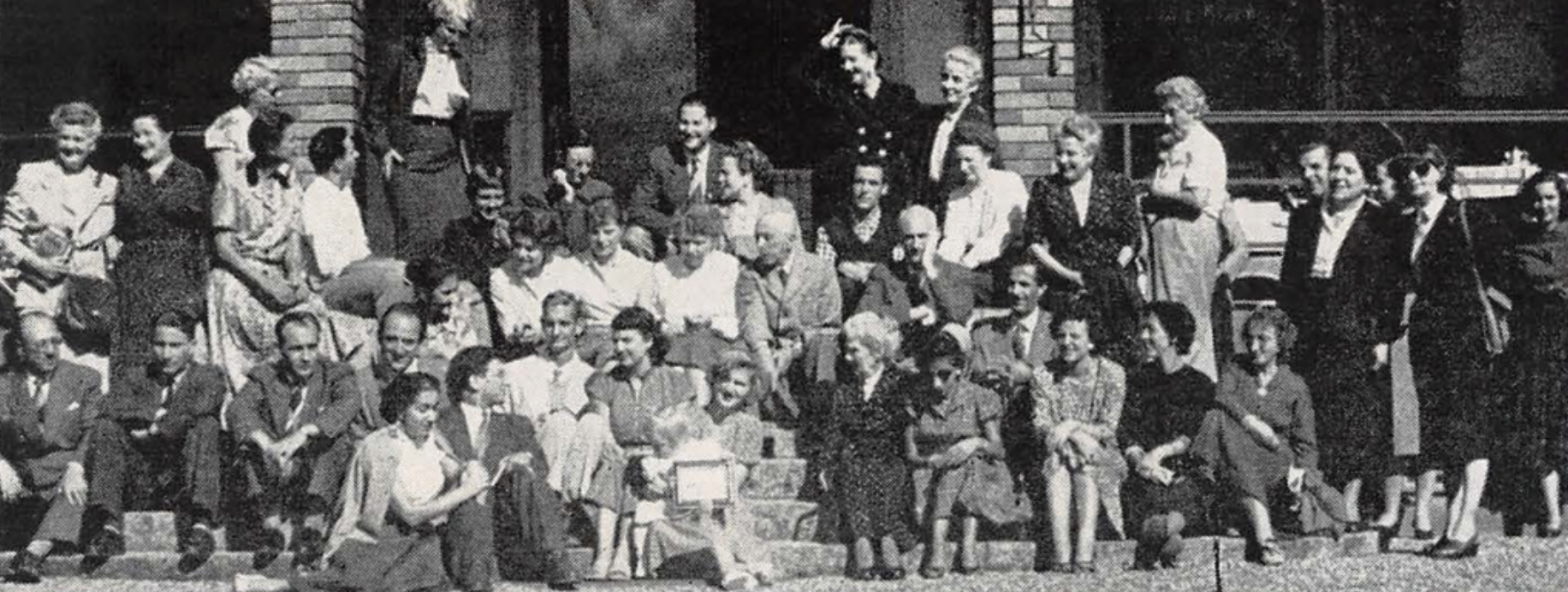
First Italo-Swiss Summer School, 1954, a community to which the Guardian extended his immense generosity by contributing funds for the purchase of land for the House of Worship the year before in 1953. Source: Bahaimedia.
The Guardian was not only the architect of teaching Plans, he was also their engineer.
The Bahá'í community was enthusiastic, passionate, enkindled, and willing, but not always able, and Shoghi Effendi was always there to provide assistance to, what he intimately knew, were, essentially, a very small band of helpers. There were simply not that many Bahá'ís, and without Shoghi Effendi’s constant help, both his encouraging words, and his financial contributions—made possible by Ḥuqúqu’lláh payments— the victories we so admire, the heights of heroism we are so inspired by, would simply not have been possible.
In 1953, after the Intercontinental Teaching Conferences, Shoghi Effendi sent £500 to the Central American National Assembly, and £1,000 to the Italo-Swiss National Assembly to help purchase their sites for Houses of Worship. Shoghi Effendi also helped the National Spiritual Assembly of Iran with yearly donations to purchase historic sites.
The Guardian also contributed money to assist the British and Indian National Spiritual Assemblies in publishing Bahá'í literature in the Plan’s goal languages. Because the Ten Year Crusade had an ambitious goal of publishing Bahá'í literature in 91 languages, this was an area which Shoghi Effendi frequently supported over the course of the next 10 years, in a large variety of ways.
Sometimes, Shoghi Effendi donated smaller amounts of money to help with local goals, such as the £50 he donated to the Bahá'ís of Tasmania when they launched their first State Teaching Campaign. On numerous occasions, Shoghi Effendi also covered the travel or relocation costs of Bahá'í teachers and pioneers, later even covering the travel expenses of Hands of the Cause.
The Guardian also offered generous, meaningful donations for spiritual events. When he had finally removed the remains of Ásíyih Khánum and Mírzá Mihdí from the 'Akká cemetery and re-interred them in the Monument Gardens in Haifa, he made a significant 1,000 donation to the North American House of Worship in their memory. There were countless times when Shoghi Effendi also paid for the tombstone of dearly loved Bahá'ís, as a mark of his personal respect and affection.
Whenever there was a disaster, if Bahá'í villagers were persecuted in Iran, or when Russian pioneers were expelled, if an earthquake or a flood tore through lands, Shoghi Effendi rushed to the assistance of the believers.
The greatest single contribution of the Guardian's ministry was his pledge of one-third of a million dollars—nearly 4 million dollars in today’s currency—towards the building of the three Houses of Worship which became goals for the Ten Year Crusade.
SOURCES FOR PART XVII

Early 1953: The story of Collins Gate
Sweet Enchanting Stories. Aziz Rohani (comp.) & (ed.), Juxta Publishing Ltd, (2005), pages 41-42.
Milly: A Tribute to Amelia E. Collins. A. Q. Faizí, George Ronald, Oxford, 1977, pages 22-24.
12 – 18 February 1953: First Bahá’í Intercontinental Teaching Conference (Kampala, Uganda)
The Priceless Pearl, Rúḥíyyih Rabbání, Bahá’í Publishing Trust, London, 1969, pages 412-414.
Bahaipedia: 1953.
The Bahá’í World Volume 12: Report of the African Intercontinental Teaching Conference, pages 124-130.
Messages to the Bahá’í World: 1950–1957, Shoghi Effendi, Bahá’í Publishing Trust, Wilmette, Illinois, 1971, pages 135-140.
My life my trees, Richard St. Barbe Baker, Forres: Findhorn (1979), page 110.

21 March 1953: Six acres of land on Mount Carmel
Leroy Ioas: Hand of the Cause of God, Anita Ioas Chapman, George Ronald, 1998, page 209.
Messages to the Bahá’í World: 1950–1957, Shoghi Effendi, Bahá’í Publishing Trust, Wilmette, Illinois, 1971, page 48.
Riḍván 1953: Achievements of the second Seven Year Plan (1946 – 1953)
The Priceless Pearl, Rúḥíyyih Rabbání, Bahá’í Publishing Trust, London, 1969, pages 403-408.
21 April 1953: The Shrine of Bahá’u’lláh: Light upon light
The Priceless Pearl, Rúḥíyyih Rabbání, Bahá’í Publishing Trust, London, 1969, pages 89-90.

2 May 1953: The dedication of the House of Worship for North America in Wilmette, Illinois
The Bahá’í World Volume 12: Report of the American Intercontinental Teaching Conference, pages 142-157.
A Tribute to Amatul’Bahá Ruḥíyyíh Khánum, Violette Nakhjávání.
The 18 inscriptions over the doors of the House of Worship in Wilmette
The dawning place: The building of a temple, the forging of the North American Bahá’í community, Bruce, W. Whitmore, (1984), pages 268-296.

3 May 1953: Second Bahá’í Intercontinental Teaching Conference (Chicago, United States)
The Priceless Pearl, Rúḥíyyih Rabbání, Bahá’í Publishing Trust, London, 1969, pages 412, 414-416.
Bahaipedia: 1953.
The Bahá’í World Volume 12: Report of the American Intercontinental Teaching Conference, pages 142-157.
Messages to the Bahá’í World: 1950–1957, Shoghi Effendi, Bahá’í Publishing Trust, Wilmette, Illinois, 1971, pages 142-146.
Wikipedia: Hands of the Cause.
Email communication with Bahíyyih Nakhjávání dated 3 December 2023 sharing the transcript of Dorothy Baker speaking about the ‘Alí Nakhjávánís of America.
Bahá’í Works: Transcript of Dorothy Baker Speaking at the 1953 Intercontinental Conference, Timestamp: 00:02:07.
3 – 6 May 1953: The Guardian’s irrepressible joy at news from the All-American Conference
Leroy Ioas: Hand of the Cause of God, Anita Ioas Chapman, George Ronald, 1998, page 259.

10 May 1953: Rúḥíyyih Khánum’s pilgrimage to her father’s grave
The Priceless Pearl, Rúḥíyyih Rabbání, Bahá’í Publishing Trust, London, 1969, page 158.
Maxwells of Montreal, The: Middle Years 1923-1937 Late Years 1937-1952. Violette Nakhjavani, George Ronald, Oxford (2011), Kindle Edition, Location 8750.
A Tribute to Amatul’Bahá Ruḥíyyíh Khánum, Violette Nakhjávání.
May 1953: The first and only American Bahá’í Shrine: 1548 Pine Avenue
Maxwells of Montreal, The: Middle Years 1923-1937 Late Years 1937-1952. Violette Nakhjavani, George Ronald, Oxford (2011), Kindle Edition, Location 8750.
The Covenant of Bahá’u’lláh, Adib Taherzadeh, George Ronald, Oxford, 1992: Chapter 32: The Faithless Relatives of Shoghi Effendi.
Messages to the Bahá’í World: 1950–1957, Shoghi Effendi, Bahá’í Publishing Trust, Wilmette, Illinois, 1971, Cable dated 17 May 1953, page 48.

July 1953: The Covenant-breaker property on Mount Carmel
Leroy Ioas: Hand of the Cause of God, Anita Ioas Chapman, George Ronald, 1998, pages 211-212.
21 – 26 July 1953: Third Bahá’í Intercontinental Teaching Conference (Stockholm, Sweden)
The Priceless Pearl, Rúḥíyyih Rabbání, Bahá’í Publishing Trust, London, 1969, pages 413 and 416-418.
Bahaipedia: 1953.
The Bahá’í World Volume 12: Report of the European Intercontinental Teaching Conference, pages 171-178.
Messages to the Bahá’í World: 1950–1957, Shoghi Effendi, Bahá’í Publishing Trust, Wilmette, Illinois, 1971, pages 157-162.
Citadel of Faith, Shoghi Effendi, July 1953.
The Bahá’í World Volume 12: In Memoriam: Siegfried Schopflocher.
Bahaipedia: Siegfried Schopflocher.
The Bahá’í Encyclopedia Project: Schopflocher, Siegfried (1877–1953).

20 July 1953: Ella Bailey arrives in Tripoli, Libya
26 August 1953: The Martyrdom of Ella Bailey, Knight of Bahá’u’lláh
REFERENCES FOR THE TWO PREVIOUS STORIES:
Leroy Ioas: Hand of the Cause of God, Anita Ioas Chapman, George Ronald, 1998, pages 267-270.
Bahá’í Chronicles: Ella Bailey.
Messages to the Bahá’í World: 1950–1957, Shoghi Effendi, Bahá’í Publishing Trust, Wilmette, Illinois, 1971, page 170.
7 – 15 October 1953: Fourth Bahá’í Intercontinental Teaching Conference (New Delhi, India)
The Priceless Pearl, Rúḥíyyih Rabbání, Bahá’í Publishing Trust, London, 1969, pages 413 and 418-420.
Bahaipedia: 1953.
The Bahá’í World Volume 12: Report of the Asian Intercontinental Teaching Conference, pages 181-188.
Messages to the Bahá’í World: 1950–1957, Shoghi Effendi, Bahá’í Publishing Trust, Wilmette, Illinois, 1971, pages 163-169.

7 – 15 October 1953: The unveiling of the design of the International Bahá’í Archives
The Priceless Pearl, Rúḥíyyih Rabbání, Bahá’í Publishing Trust, London, 1969, pages 263-266.
Coronation on Carmel: The Story of the Shrine of the Báb Volume II: 1922-1963, Michael V. Day, George Ronald, 2018, pages 263-264.
13 December 1953: A separate Bahá’í department at the Ministry of Religious Affairs
The Priceless Pearl, Rúḥíyyih Rabbání, Bahá’í Publishing Trust, London, 1969, pages 290-291.
Wikipedia: Ministry of Religious Services
REFERENCES FOR THE PREVIOUS TWO STORIES:
Leroy Ioas: Hand of the Cause of God, Anita Ioas Chapman, George Ronald, 1998, page 212.

Early – Late December 1953: Curtis Kelsey returns to the Holy Land
Curtis Kelsey feels the divine power of the Guardian
Curtis Kelsey and the water pump at Bahjí
The high point of Curtis and Harriet’s pilgrimage
REFERENCES FOR THE PREVIOUS FOUR STORIES:
He Loved and Served: The Story of Curtis Kelsey. Nathan Rutstein, George Ronald, Oxford, 1982, Chapter 13.
Bahaipedia: Curtis Kelsey.
The Bahá’í World Volume 15: In Memoriam: Curtis DeMude Kelsey.

16 December 1953: Covenant-breakers: The death of Avárih, “shameless apostate”
Messages to the Bahá’í World: 1950–1957, Shoghi Effendi, Bahá’í Publishing Trust, Wilmette, Illinois, 1971, Cablegram of 16 December 1953: Fast-Dwindling Band of Covenant-Breakers, pages 53-54.
Wikipedia: Abd al-Hosayn Ayati.
Other Covenant-breakers in the East
The Covenant of Bahá’u’lláh, Adib Taherzadeh, George Ronald, Oxford, 1992 Chapter 31: Rebellion in the West.
Messages to the Bahá’í World: 1950–1957, Shoghi Effendi, Bahá’í Publishing Trust, Wilmette, Illinois, 1971, Cablegram of 16 December 1953: Fast-Dwindling Band of Covenant-Breakers, pages 53-54.
The Priceless Pearl, Rúḥíyyih Rabbání, Bahá’í Publishing Trust, London, 1969, page 19.

Shoghi Effendi’s dinners with pilgrims
Pilgrim’s notes about Shoghi Effendi, Ramona Brown, published in Memories of ‘Abdu’l-Bahá: Recollections of the Early Days of the Bahá’ís of California, pages 111-118 Wilmette, IL: Bahá’í Publishing Trust, 1980.
Transcript: The Guardian of the Bahá’í Faith, 21 June 1970, Amatul’Bahá Rúḥíyyih Khánum, transcript from a cassette tape published by the Bahá’í Publishing Trust.
Shoghi Effendi’s pride at heroic Bahá’ís
The Priceless Pearl, Rúḥíyyih Rabbání, Bahá’í Publishing Trust, London, 1969, pages 126-127 and 161.
Shoghi Effendi’s love for all indigenous peoples
The Priceless Pearl, Rúḥíyyih Rabbání, Bahá’í Publishing Trust, London, 1969, pages 135-136 and 138.
Encyclopedia Britannica: Inuit. Note: The original reference in this story to Inuit was Eskimo, but this term is now pejorative and culturally inappropriate.
Encyclopedia Britannica: Attar of roses.
Natural Perfumery Blog: Rose attar.
Arohanui: Letters from Shoghi Effendi to New Zealand, Number 66: 27 June 1957, Letter on behalf of Shoghi Effendi to the National Spiritual Assembly of New Zealand, pages 72-76.
A Special Measure of Love: The importance and nature of the teaching work among the masses, Messages from Shoghi Effendi and the Universal House of Justice, From letter dated July 2, 1956, written on behalf of Shoghi Effendi to the National Spiritual Assembly of North West Africa, page 15.
Shoghi Effendi’s love for Native Americans
The Priceless Pearl, Rúḥíyyih Rabbání, Bahá’í Publishing Trust, London, 1969, pages 137-138.
Shoghi Effendi’s letter of 28 July 1957 to the Regional Spiritual Assemble of Central America.
A Special Measure of Love: The importance and nature of the teaching work among the masses, Messages from Shoghi Effendi and the Universal House of Justice, Letter written on behalf of Shoghi Effendi to one of the National Spiritual Assemblies of Latin America, dated July 1957, pages 19-20.
Shoghi Effendi’s unique perspective on prisoners
The Priceless Pearl, Rúḥíyyih Rabbání, Bahá’í Publishing Trust, London, 1969, page 136.
Messages to the Bahá’í World: 1950-1957, Shoghi Effendi, page 107: Riḍván Message 1957.
Lights of Guidance: 251: If One Desires to Become a Bahá’í, His Past Should Not Be Held Against Him, letter of 23 April 1955, to the Spiritual Assembly of Honolulu.
Unfolding Destiny: Letters and telegrams by or on behalf of Shoghi Effendi to British Bahá’ís from 1922 to 1957, Shoghi Effendi, Letter of 5 August 1955, page 352.
Unfolding Destiny: Letters and telegrams by or on behalf of Shoghi Effendi to British Bahá’ís from 1922 to 1957, Shoghi Effendi, Letter of 8 April 1948, pages 449-450.
Shoghi Effendi’s generous financial assistance
The Priceless Pearl, Rúḥíyyih Rabbání, Bahá’í Publishing Trust, London, 1969, pages 421-423.
![]()
 12 – 18 February 1953: Shoghi Effendi calls on an old friend to welcome African Bahá'ís to the conference
12 – 18 February 1953: Shoghi Effendi calls on an old friend to welcome African Bahá'ís to the conference


























